Ananda Mandir
269 Cedar Grove Lane
Somerset, NJ 08873


Ananda Mandir
269 Cedar Grove Lane
Somerset, NJ 08873

This is the story of a lake and a mountain. It is an ancient story. But just like any other ancient story this story can also be told many, many times, and there will always be listeners gathering around the storyteller. It is because each storyteller has a unique voice and every time the tale is told it is colored by the storyteller’s own feelings and imagination. Thus, one story gives birth to a number of different stories. In the Ngari Prefecture of Tibet at an altitude of almost 15,000 ft(4,600m.) there lies a glorious lake. The lake is called MapamYumtso in the local language. The words MapamYumtso come from Tibetan Mapam (meaning invincible) and Tso Madropa(meaning ground heated by the sun). These words are combined with ‘tso’ which simply means lake in Tibetan. Even from the etymology one can tell its importance in Tibetan culture and something about its physical appearance. The lake is unconquerable; it protects the land and its people. The lake has such power that it defeats even the worst of the enemies who try to tarnish the purity of the land surrounding it. If you stand by the lake you can see through the depth of it. The water is crystal clear. It is rare to find a freshwater lake at such a high altitude. The Tibetan plateau is mostly studded with salt water lakes.
I am going too fast now. Let me rewind a little and I promise, in the end I will come back by the lake again. The flight duration of China Eastern Airlines from Chengdu to Lhasa was close to three and a half hours. The plane did not even touch the ground then. I was dozing off. The time difference between Chicago and my destination was 13 hours. No wonder my
By Ranjita Chattopadhyay (Illinois)
body clock was going haywire. My husband gave me a not so gentle nudge. ‘Look down’. There was excitement in his voice which woke me up. With sleepy eyes I looked outside the plane window, a little irritated at him. And I realized immediately why he had to wake me up and I was happy he did. No one would want to miss the drama below. The sky, the clouds and the mountains took over the entire stage and the drama was spectacular. Lhasa Airport was not too big at all. We got our luggage and came out in less than an hour. As we came out, we met the representative of our tour company. The first thing he did was to put white silk scarves around us. He told us that the scarf was called ‘kata’. We immediately felt at home. Later I learnt that welcoming tourists with a prayer scarf is a common custom in Tibetan Buddhism. This small and simple gesture symbolizes gratitude, interconnectedness and respect. And with that began our 14-day trip across Tibet.Tibet,the land of mountains, monasteries and mysticism.
Our tour bus ran along the smooth highway from Lhasa to Shigatse, to Everest Base Camp, to Saga, to Darchen. We spent one or two nights in each of these cities. It helped us to acclimatize with the altitude. The Tibetan Plateau is the highest plateaus in the world with an average elevation of 14,800 ft. So, it is hard for the travelers to escape the grip of altitude sickness. The unique landscape of this region greeted our eyes as we continued on our way. The horizon was no longer a straight line. The towering mountains bordered the sky. Sometimes the tops of the
hills were rolling. As soon as the Himalayan ranges appeared the summits looked distinctly angular.Oureyes never got tired seeing the
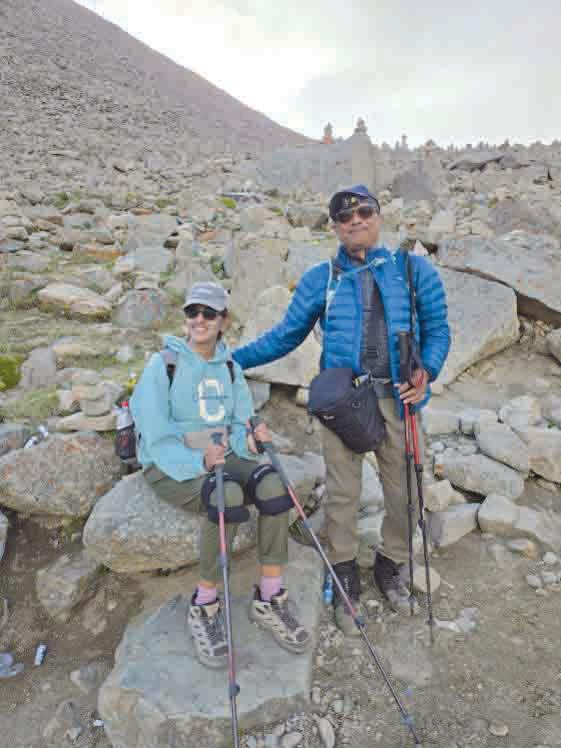
changing patterns and shades of blue, green, gray and brown where the sky met the land. From Darchen we started our Kailash Kora, trekking around Mt. Kailash
continue to page 6 }
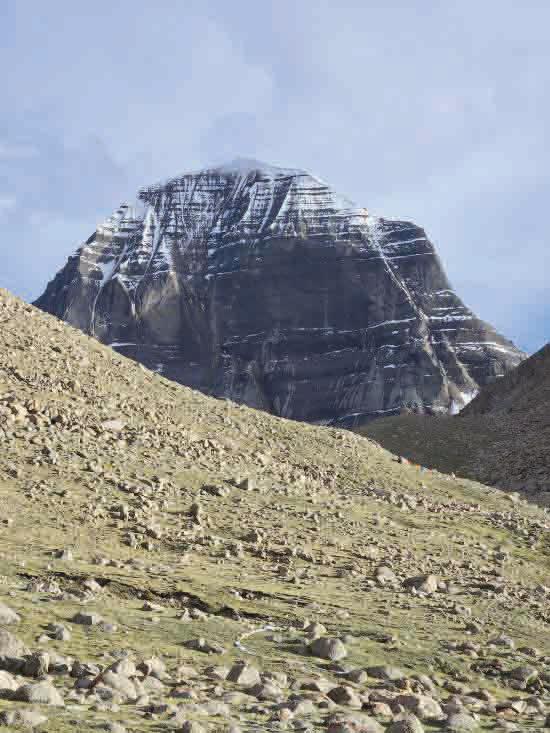

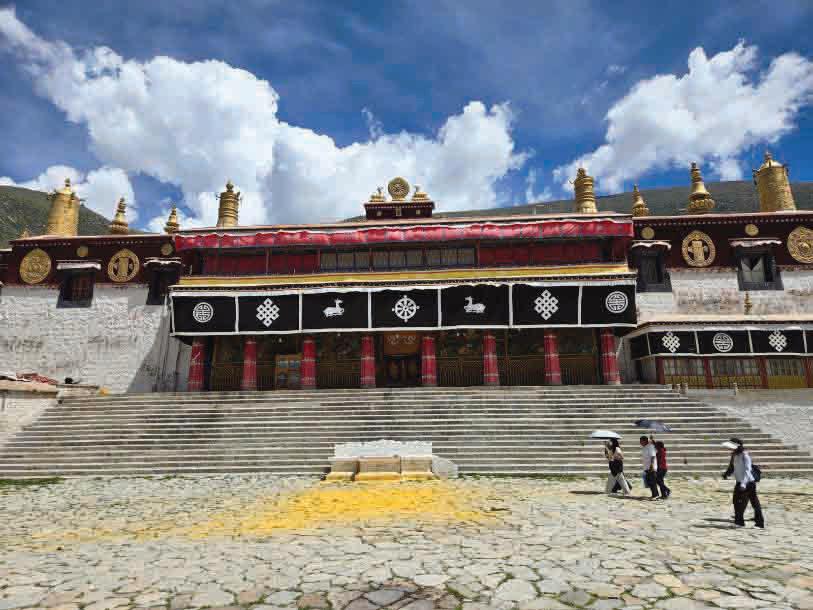
NJ PERMIT NO. 1215
Calendar of Events (Dates are subject to Change) Please check our website frequently www.anandamandir.org Tel: 732-873-9821
NOTE: For Puja time please contact temple or visit our website: anandamandir.org
OCTOBER 2024
Pitri Tarpan
Wednesday, 2
Shri Shri Durga Puja
Tuesday, 8 to Saturday, 12
Shri Lakshmi Puja & & Satyanarayn Puja, Wednesday, 18
NOVEMBER 2024
Shri Shri Jagatdhatri Puja
Sunday, 10
Satyanarayan Puja & Raas Jatra
Friday, 15
Shyama Puja
Saturday, 30
December 2024
Satyanarayan Puja
Sunday, 15
Shyama Puja
Monday, 30
JANUARY 2025
Satyanarayan Puja
{New Year’s Day} Wednesday, 1
Satyanarayan Puja, Sunday, 12
Ratanti Kalika Puja Monday, 27
Shyama Puja, Tuesday, 28
(*) See www.anandamandir.org or Call Mandir for details
Special Religious Services: Upon request, the priest of Ananda Mandir offers services such as in-house Shraddhas, Rituals associated with Cremations (Antyesti Kriya), Shraddha Anniversaries, Pre-wedding rituals (Naandimukh, Ashirwad, etc.), Upanayan (Paitey), Annaprasan, Wedding Ceremonies & Wedding Anniversaries, Griha Prabesh (Bhumi Puja), Consecrations of new cars (New Car Pujas) and others. If you have needs for any of the above or more, please feel free to contact Biswabhai @ 732-873-9821
TMANDIR
A Periodical Newsletter Published By ANANDA
(A Tax-Exempt, Non-Profit Organization)
269 Cedar Grove Lane Somerset, NJ 08873
Phone: 732-873-9821
Website: www.anandamandir.0rg
Debajyoti Chatterji Executive Editor (Acting)
All queries, articles, news reports and letters should be directed to debsmees572@gmail.com Phone: 908-507-9640
For general information, please contact the following executives of Ananda Mandir:
Anjan Lahiri President
Jai Prakash Biswas Vice President
Debajyoti Chatterji Vice President
Ashok Rakhit Vice President
Arun Bhowmik General Secretary
Sanchoy Das Treasurer
Pradip Majumdar Assistant Treasurer
BECOME A MEMBER OF ANANDA MANDIR AND PARTICIPATE IN THE COMMUNITY ACTIVITIES TO ENRICH YOUR FAMILY
he Independence Day of Indiais solemnly celebrated on the 15th of August every year/ The celebrations remind us of the dawn of a new beginning, the beginning of an era of deliverance from the clutches of British colonialism of more than two centuries. It was on this date in 1947 that India freed herself from British colonialism, and the reins of control were handed over to the country’s citizens. India’s gaining of independence was a tryst with destiny, as the struggle for freedom was a long and tiresome one, witnessing the sacrifices of many freedom
By Subhrojit Dutta (New Jersey)
fighters.
This year Ananda Mandir celebrated 78th anniversary of Indian Independence Day on Aug 18, 2024.The event commenced with a procession led by Biswabhai, and flag-hoisting [of both India and the US] and chanting of Indian National Anthem “Jana Gana Mana” by community adults and children. The singing was accompanied by Anooshka Sen on violin/ This was followed by the US National Anthem, led by Shreya. Sequentially.A brief cultural
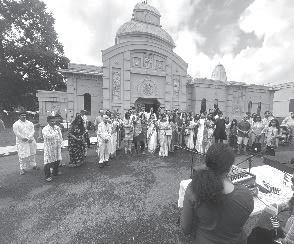
program followed, featuring the following speakers and performers: Prof Dipak Sarkar, a past president, gave a brief overview of India’s struggles to gain freedom, and the song, “Vande Mataram”,was sung by Aishik. A
Write-up on independence was narrated by Ayushman Mukherjee, and “Swadhinotar Sukh” was recited by Sumeshnee, A recitation by Ishanaa, Performance by Shreya’s students: Ridhik, Aditya and Hridaan, “Dhonodhanno-
pushpobhora” performed in chorus by Ananda Mandir community adults, A recitation by Amitabha Chell, A song was sung by Arun Bhowmik, Orchestra: by Sayan, Soumyanil, Indrayan and led by Shreya. Aishi played the role of MC, and the sound was set up by Srijon, Shaon and Indranil. Overall co-Ordinator for the cultural program was Sudipta.Bhanja Choudhury. Like last year, Ananda Mandir also conducted a food drive for the Franklin Township Food Bank. Members, friends and patrons donated benevolently to make the drive a success.
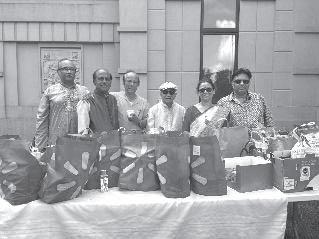
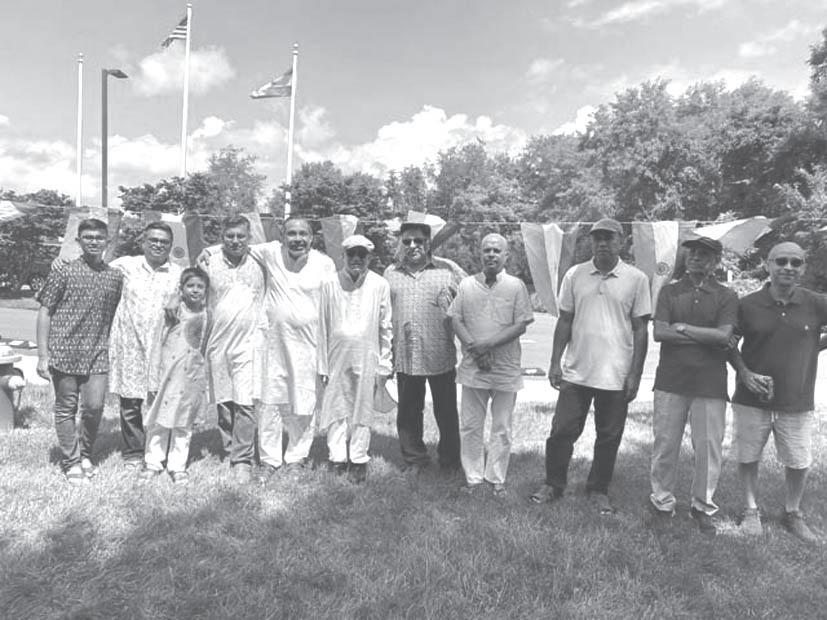
By Amitabha Bagchi (California)
The young man was positively dismissive -- openly scoffing at my plan. “You think you will see tigers?” he chortled. “All you will see are pawprints!” Here he bent down and pointed to the floor, imitating the pose of a safari guide. “’Look at the pugmarks! A tiger was here minutes ago, walking this way.’ As you squint at the dirt, trying to discern a tiger’s pugmarks from the impressions left by the hooves and paws of sundry animals, he will whisk you on a chase of the phantom feline.” He rose and gave me a self-satisfied smile.
The above exchange took place as my wife and I were having dinner with the young man -- her nephew -and his wife. He was reacting to the description of my plan to travel to tiger reserves in central India and go on safaris to catch a glimpse of tigers in the wild. I admit that his pantomime left me more than a tad disheartened. Ever since I watched the excellent National Geographic documentary, “Land Of The Tiger,” on PBS in the eighties, I have been obsessed with the idea of visiting Kanha National Park – India’s major tiger reserve and the principal locale of the film. (A smaller porion of the documentary was shot in Ranthambore.) Now I felt as if a bucket of cold water had been thrown at my dream.
To be honest, I too had my own worries about tiger sightings. Most tigers found in India belong to the subspecies known as the (Royal) Bengal Tiger. But sighting tigers in Bengal’s own forests – Sunderbans in the south or Terai in the north – has become rare indeed. Unchecked hunting and poaching over more than a hundred years led to such a decline in tiger population that tiger conservation became an environmental imperative to save the species from extinction. What were my chances, really, of spotting the big cat in a large forest? I wondered.
II. Kanha National Park
Kanha National Park is perhaps the largest tiger reserve in India and has, per the latest count, close to 500 tigers. But the forest stretches over a vast area, giving tigers ample space to evade the prying eyes of visitors. I was therefore advised to include in my itinerary a stop at a nearby, smaller tiger reserve -- Bandhavgarh National Park -- to improve my odds of spotting a tiger in the wild. That was, in retrospect, sound advice.
My wife and I started our journey from Kolkata – first flying into Raipur, the capital of Chhattisgarh. Our itinerary was drawn up by a travel agent, who had arranged places for us to stay, and rental cars and drivers to take us between locations. After an overnight stay in Raipur, we
went on a half-day drive through a hilly and agricultural area of Madhya Pradesh to Singhania Jungle Lodge on the outskirts of Kanha.
We were not sure what to expect, but Singhania Jungle Lodge turned out to be an unforgettable experience. In some ways it resembled the jungle lodge where we had stayed in Kruger National Park (in South Africa) – but even better in terms of amenities and support personnel. Configuration wise, it consisted of a handful of wooden cottages scattered around a rather substantial two-story central building which housed the reception desk, a wide lobby, and several dining rooms. What blew us away was the bed being made twice a day: once in the morning and again in the evening – inviting guests to turn in, with a few candies left on the bed as a kind of nightcap. At dinnertime, the waiters served soups and entrees from the left and cleared plates from the right, in a beautiful (if bewildering) display of proper etiquette. It was pampering par excellence.
The lodge boasted of an in-house naturalist – a lively young man who had a Ph.D. in information technology (databases, to be precise) but clearly preferred to live and work in close proximity to nature. When I told him about the National Geographic documentary on tigers in Kanha, he instantly mentioned the name of the naturalist who had helped the film makers with the project. When my wife expressed a desire to watch tribal dances, he arranged an openair dinner one night under a canopy of trees, and invited some musicians and dancers from a local tribe to perform for the hotel guests around a fire-pit.
We spent two days and three nights at Kanha National Park. The travel agent had booked two safaris for us on the first day – one in the morning and one in the afternoon – and a single one in the morning of the second day. The plan for Bandhavgarh was the same. We thus had six safaris for a crack at seeing India’s tigers in the wild.
The first morning, we had to get up at five and go to the main building by five-thirty for a wake-up cup of tea and light snacks. The hotel folks made box lunches for us, and by six o’clock we were off in a jeep to the gate of Kanha and the starting point of the safari. The February air was raw and nippy, and the jeep ride was quite unpleasant in our groggy state. The safari jeeps had three decks for sightseers, similar to the jeeps at Kruger, but had a narrower width. Unlike Kruger, there was no security person carrying a rifle and riding up front next to the driver.
On the first safari, we saw a wide range of animals. On land, we saw spotted deer (chital); barasingha (literally “twelve horned”) swamp deer that feed on (among other vegeta-
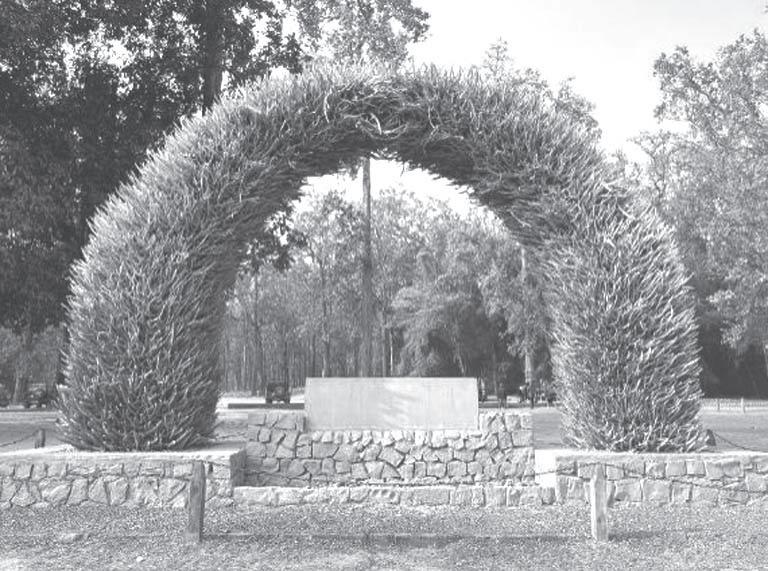
tion) aquatic plants and algae; a troop of langur monkeys seated in a neat row on a fallen tree trunk; enormous gaurs; wild boars; wild elephants and strutting peacocks courting disinterested peahens. On trees and in the air, there were birds galore: eagles, vultures, kingfishers, and the everwarbling barbets, to name but a few. But – and here is a big BUT – we saw no tigers! (We saw, however, what the guide claimed to be pugmarks or tiger tracks. (Sure enough, that brought back uncomfortable memories of my dinner conversation with my wife’s nephew!) When we paused for lunch in the central part of the forest, which boasted a pretty arch (see photo) made up of antlers shed by stags, my wife vented her disappointment and frustration by suggesting that we skip one of the safaris and go instead to a tribal village to see tribal jewelry.
I have to admit I was a bit subdued when we embarked on our second safari in the afternoon. Was I wrong to come to Kanha? Once again, we encountered the diverse faunas of the region, but were mostly squinting at pawprints of quadrupeds on dirt, mixed with the scratchy footprints of bipeds (birds) when – voila! – there came a tiger ambling out of the forest at some distance. He started moving toward a large watering hole but paused after a few steps and lay down on grass in a relaxed posture (see photo). All nearby safari jeeps
stopped, as the tourists brought out their cameras. Someone said that it was a baby tiger, perhaps a year old, although it looked plenty large to me. At any rate, my tension at not seeing a tiger in the wild vanished in an instant. The trip had finally achieved its purpose!
The following morning, our third safari began in a manner that was a bit repetitive and anti-climactic. Then came a sudden burst of excitement. I was told that there was a tiger out yonder. Being chromatically challenged, I could see only tall yellow grass in front of me. Nevertheless, with barely suppressed excitement, I looked intently through my camera lens when, all of a sudden, a reddish striped tail rose above the tall grass. Pretty soon, the head became visible as the (female) tiger rose from her crouched position, where she was patiently waiting to surprise an unsuspecting prey. I was left to wonder about nature’s ability to provide camouflage to both the hunter and the hunted, and our superior ability to discern motion as opposed to a stationary object that blends with its environment.
From Kanha my wife and I went to
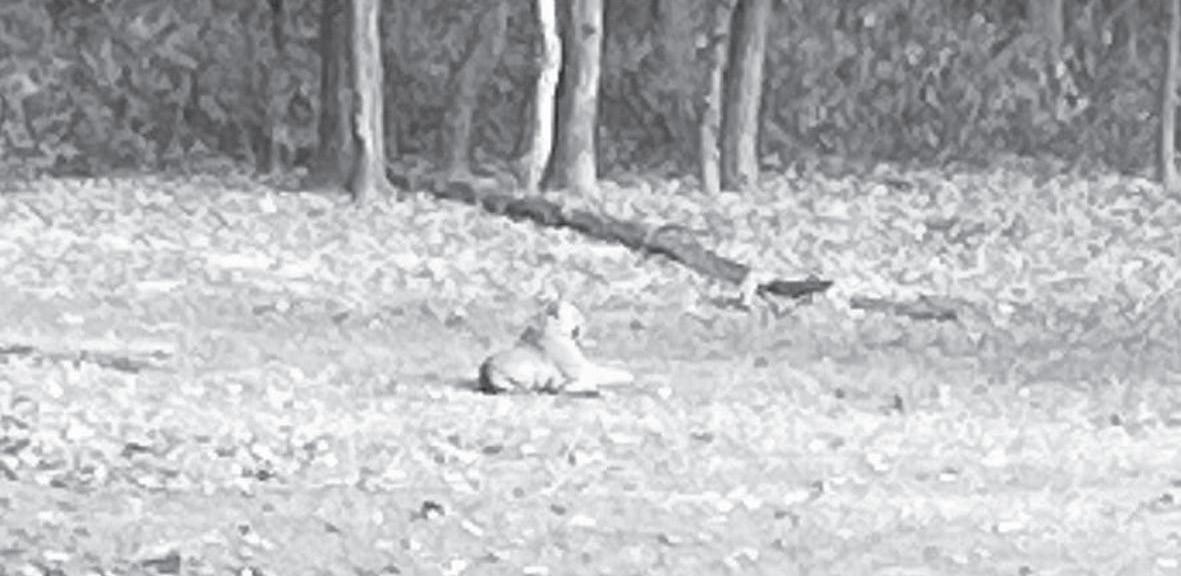
It was October, 2014. We flew to Shanghai, China, and then traveled by train to Suzhou, to attend China’s first biotech conference. We were invited guests from America. All the arrangements, including our visas, had been made by Chinese organizations.They provided beautiful hotels with plenty of amenities just like five-star hotels in America. Our hotel overlooked a pond. So, we had a beautiful scenic view. The morning after the day of our arrival in Suzhou, while searching for food at the buffet breakfast that offered Chinese, Western, and international dishes, I met Ananda-da. His excitement to see me was matched by my own. Over the next three days, we shared meals and discussed various scientific topics, further deepening my admiration for his work and gaining new insights. Ananda-da came to China as an advisor, particularly on how to set up a Recombinant DNA Laboratory. His next journey was from China to Kolkata, where he would be the chief guest at the Narendrapur University convocation at Narendrapur.
I had known Ananada-da for quite some time. I did not know him in India, but I knew him from the early part of my life in USA. Then we became close to each other. One day I found out that he knew Sanskrit well, and he used to chant the Gayatri Mantra every morning, saying that he had read most of the Hindu Epic, Mahabharata, in Sanskrit with his father. I should mention that whenever I was in trouble, I used to reach out to Ananda-da for advice. He helped me always. His helping hand was always open.
This Ananda-da is the famous Ananda Mohan Chakravarti, who radically changed legal opinions on ownership of “genetically engineered organisms” in 1981 and inadvertently encouraged unprecedented levels of biotech innovation and commercialization in subsequent years. The U.S. biotech industry developed tremendously which was not possible without his work, keeping both biomedical science and the law side by side.
Ananda Mohan Chakravarti, born on April 4, 1938, in Sainthia, West Bengal, India, was the youngest of seven children. From an early age, he showed a keen interest in science and the Sanskrit language. He completed his early education at Sainthia High School and Ramakrishna Belur Vidyamandira before earning a bachelor’s degree in chemistry from St. Xavier’s College, Kolkata. He later obtained his MSc and PhD in Biochemistry
By Alok Bandyopadhyay (Pennsylvania)
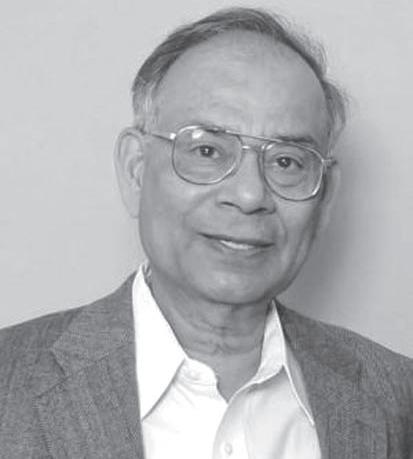
from the University of Calcutta under the mentorship of Prof. Sailesh Chandra Ray.
Chakravarti ‘s journey in research began in 1965 when he performed his postdoctoral training under Prof. Irwin ‘Gunny’ Gonzalez at the University of Illinois at Urbana-Champaign. In Gonzalez’s laboratory, Chakravarti learned about the pathways of hydrocarbon decay in a Pseudomonas bacteria.
His groundbreaking work began in 1971 at the General Electric Company’s R&D Center (GE) in Schenectady, New York. Here, he genetically engineered a new species of Pseudomonas bacteria, capable of metabolizing oil at a much faster rate than existing strains. This “superbug,” later known as Pseudomonas putida, could digest about two-thirds of the hydrocarbons in a typical oil spill. This innovation gained international attention when GE applied for a US patent on behalf of Chakravarti. This was the first-ever attempt to patent a “man-made” life form, for a genetically modified organism.
Chakravarti ‘s patent application for his genetically engineered bacterium faced initial rejection from the U.S. Patent Office, which argued that living organisms could not be patented. However, GE took the matter to the United States Customs and Patent Appeals Court where the decision of the US Patent Office was overturned. The case eventually reached the U.S. Supreme Court. In a landmark decision in 1980, the Supreme Court ruled in favor of Chakravarti (and GE) stating that “a live, human-made microorganism is patentable matter” under Title 35 U.S.C. 101.
This decision not only secured the
patent for Chakravarti but also set a precedent that paved the way for numerous patents in later years by other researchers on genetically modified organisms. This ruling was instrumental in the subsequent growth of the U.S. biotech industry, enabling companies to innovate and commercialize biotechnological advancements without fear of legal obstacles.
This decision opened the door for patents on genetically modified organisms, particularly superbugs, and spurred the growth of the U.S. biotech industry. GE took a prominent role in developing a bioremediation path to help clean up environmental pollutions such as oil spills using the Chakravarti “superbug”. .Several companies expressed keen interest in being collaborators. This was an exciting time for young scientists. Unfortunately, commercialization of “superbugs” for clean-up of oil spills proved to be elusive because of many questions, some answerable, some not. Time required for large scale production of superbugs to address a huge oil spill could not be predicted. Also, how rapidly the superbugs would eat up the oil was not known. Finally, would it be wise to release “man-made bacteria” on a natural resource like the ocean without knowing the long-term consequences? As a result, GE had to drop its efforts to commercialize the Chakravarti “superbug”.
Chakravarti’s research laid the foundation for modern biotechnology. His work on genetically engineered organisms paved the way for the commercialization of many subsequent biotech innovations, including life-saving treatments such as insulin therapy. The establishment of Genentech in California, the first U.S. biotech company, was built on the principles of Chakravarti’s research. Federal legislation, such as the BayhDole Act of 1980, further supported private sector innovation, allowing universities and small businesses to retain ownership of their inventions.
After leaving GE, Chakravarti served as a professor of microbiology and immunology at the University of Illinois College of Medicine in Chicago. He was also a member of the National Research Council’s biotechnology committee and an advisor to several international organizations.
Chakravarti continued his groundbreaking research, focusing on cancer regression and the role of bacterial proteins in cell cycle progression. His lab worked to elucidate the role of the bacteria cupridoxin and cytochrome in cancer regression and cell cycle progression. These proteins were previously known to be involved in bacterial electron transport. He isolated azurine, a bacterial protein with potential antineoplastic properties. He expanded his lab work to include multiple microbiological species, includingNeisseria, Plasmodia, and Aciditiobacillus ferroxidans
In 2001, Professor Chakravarti founded a company called CDG Therapeutics, (incorporated in Delaware) that holds proprietary information regarding five patents generated by his work at the University of Illinois at Chicago. The University of Illinois owns the rights to the patents, but has issued an exclusive license to CDG Therapeutics. In 2008, Professor Chakravarti co-founded Amrita Therapeutics Limited, a second biopharmaceutical discovery company registered in Ahmedabad, Gujarat, an effective therapy against cancer and/or other major public health threats derived from bacterial products found in the human body, For vaccine and diagnostic development. Amrita Therapeutics Limited received initial funding from Gujarat Venture Finance Limited in late 2008, and a grant for a two-year research programme in 2010 from the Indian Department of Biotechnology under the Biotechnology Industry Promotion Program (BIPP). Ananda-da and his coworkers completed initial clinical trial, known as Phase I and Phase 2, but were unable to proceed to Phase 3 clinical trials because of lack of industrial sponsorship and collaboration.
On the morning of July 10, 2020, we lost one of our dearest dadas, that is, Ananda-da forever. I knew his wife Mrs. Krishna Chakravarti and talked to her regarding science when I met her in Suzhou, China. We offer our deepest condolences to her and her family, At the same time, the biotech world lost one of its pioneers, but his legacy lives on through the countless innovations and advancements his work made possible. Ananda Mohan Chakravarti’s life and remarkable research changed the world, proving that with knowledge, dedication and creativity, we can overcome challenges and create a better future for all.
The Supreme Court’s decision in
Before mechanical clocks were invented, people used sundials to tell the time. “Noon” was considered to be when the sun was at its highest point in the sky, due south. As a result, each town and city had its own version of time even after the introduction of mechanical timepieces. With the invention of the transcontinental railroad, however, the lack of standardized time became problematic. As people left one city and traveled by railroad across the country, watches had to be reset frequently to accommodate the different times at each station. To solve this predicament, the U.S. borrowed the idea of time zones from Sir Sandford Fleming. A Canadian railroad engineer, Fleming had originally come up with the idea of dividing the world into 24 different longitudinally-based time zones, each with an hourly variation. The U.S. adopted this idea nationally, creating four different zones based on degrees of longitude. A year later, England, Scotland, and Wales followed suit, and eventually, the rest of the world did too.
The International Space Station Is on a Time Zone
Time zones are tailor-made for Earthlings, as they
By Pradip R. Das (New Jersey)
Introduction:For some period of time, I had been pondering to dig up some facts on time zones, a topic that has piqued my interest for a long time.Time is relative, which is part of what makes time zones around the world so fascinating. Although we’re all familiar with the concept of dividing geographical regions by time today, time zones are a relatively modern invention. Time zones were created solely to simplify our lives, when the world began to run on a standardized time, it made global transactions and international travel less complicated. I have attempted to structure my article based on facts that I deemed informative and some outright intriguing, although some may find trivial.
(roughly) align with the planet’s 24-hour-long day, but what about the people and space missions we’ve sent beyond Earth? For all missions, including those on the International Space Station, NASA uses Coordinated Universal Time (UTC). UTC is similar to GMT — they share the same current time — but with a subtle difference. Whereas GMT is just one of many time zones, UTC is a time standard. UTC is the global standard time used by scientists and it’s constantly calibrated using hyper accurate atomic clocks; scientists will also occasionally add leap seconds to make up for Earth’s
rotational irregularities.
Greenwich, London, Was the Logical Choice for the Prime Meridian
When it comes to time, the borough of Greenwich in London, England, is at the center of the world. That’s because Greenwich Mean Time (GMT) has historically been considered universal time. In 1884, Greenwich was chosen as the center of world time for reasons of convenience. First of all, a year earlier, the U.S. had based its national time zones on a meridian that ran through Greenwich. Secondly, in the late 19th century much of the world’s commerce depended on maritime trading, and most sea charts also used the Greenwich meridian as the primary point of reference. As such, this particular meridian, which ran from the North Pole to the South Pole and crossed directly through Greenwich’s Royal Observatory, became the world’s prime meridian. Set to 0 degrees longitude, the prime meridian is the line upon which GMT was established in order to set the standard for world time. In 1967, Coordinated Universal Time (UTC) was introduced as a GMT equivalent and an updated global time standard. At this point, GMT was technically reduced to just a time zone, although it’s still used as a common vernacular to tell the world’s time.
continue to page 10 }
| continue from page 3
its less affluent cousin – the Bandhavgarh National Park. It is much smaller in land area but probably has more tigers per hectare than Kanha. Such facts make it a more favorable locale for sighting tigers.
We stayed at Bandhavgarh Jungle Lodge. It is similar to, but smaller and less opulent than, its counterpart in Kanha. Our Kanha experience was replicated here on a smaller scale: fewer scattered cottages around a much smaller central building with one large dining area. During daytime, there was an artist doing sketches on the periphery of the dining hall. Our plan, replicating the earlier one in Kanha, included three safaris in two days.
The first safari through Bandhavgarh was memorable indeed. Around the mid-point of our tour, we saw several jeeps hurrying toward some spot in the forest, and our driver followed suit. Pretty soon we found ourselves among quite a few safari jeeps stuck on a dirt road, blocked by an enormous tiger lying indolently on it. As we and the other tourists gawked at the huge beast pretty much covering the road’s entire width, our guide opined that it was a fully mature male tiger that must measure ten feet from its mouth to the tip of its tail. I was happy to take his word for it – not wishing to get nearer to the animal with a measuring tape! And then, something even more amazing happened. The tiger slowly
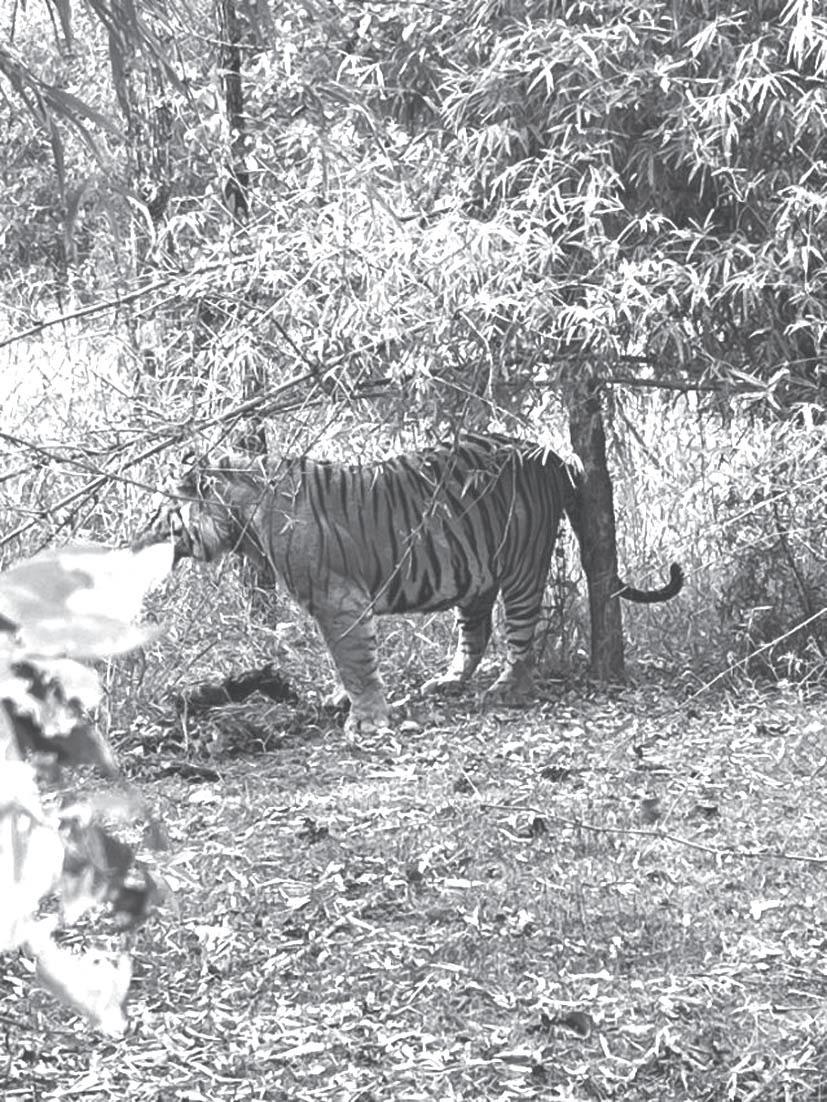
rose and walked into the forest and moved along its edge in our direction. Soon enough, we realized that it was headed towrd his kill – the carcass of a black boar in a clearing of the forest (see photo). He munched on parts of the boar’s remains before lifting the rest of it by mouth and staring straight at the onlookers from maybe forty feet. After a short while, he turned around – carcass in mouth – and disappeared into the heart of the forest to finish his dinner in seclusion and peace.
Kanha and Bandhavgarh have important topographical differences.
Kanha sits in a plateau or bowl ringed around by hills. Bandhavgarh, in contrast, sits in a hilly region. To paraphrase from the web, “The altitude of the [Bandhavgarh] reserve varies between 1345 and 2657 feet. The park contains 32 hills and has a large fort in the center that offers a magnificent view of the nearby countryside some 1000 feet below.” The hilly terrain came in handy during our second (or afternoon) safari. From a winding road hugging a hill, we could see a female tiger resting with her cubs on a ledge below. When we drove up halfway to the central fort, we could sense tigers hiding (and moving) behind tall grass around protruding ledges. Tourists are not allowed beyond the halfway point to the fort. But the reward for the truncated journey was to see an abandoned temple with an impressive stone statue of Vishnu reclining in Ananthashayan By the time we embarked on our final safari, we were tired and, furthermore, sated with tiger lore. No big cat crossed our path that time, meaning that we drew a blank on both our first and last safaris that bookended our visit to the tiger reserves. Our guide and the jeep driver were apologetic for their failure to show us tigers, worried (incorrectly) about our disappointment. Truth be told, we were more than happy with our earlier tiger-sighting successes.
I left the tiger reserves still mulling over the comments of my wife’s nephew in Kolkata. His prediction could very well have come true. As I look back, I feel that we were very lucky in realizing our principal objective of sighting tigers in the wild. Those big, striped cats are famously reclusive. I learnt from our guides that they are nocturnal creatures, mostly sleeping through the day except for the early morning and late afternoon. That behavior explains the timing of the safaris.
On our last day at Bandhavgarh, we met some Indian tourists at lunchtime. They were a group of friends who had arrived at the tiger reserve from different parts of the country. Exactly like us, they had no tigersighting on the morning safari. But the afternoon safari – their last one – gave them hope. When we met again for dinner that evening, we learned that they were no luckier on their second try. They had no more chances left; they needed to get up early the next morning to go back to their homes. I prefer not to think about what might have been my emotional state had I struck out seeing tigers on all six of our safaris. By the grace of the Tiger God, Dakshin Rai (https://en.wikipedia.org/wiki/ Dakshin_Rai)—feared and revered in the coastal villages of southern Bengal -- my wife and I were spared that indignity.
| continue from page 1
on a 52 km loop road in 3-days reaching an altitude of 18,471 ft at the highest point. Kora is the Tibetan word for circumambulation of a holy place. Completing Kailash Kora was the focal point of our Tibet trip. Mount Kailash, I read the name as a child in Abanindranath Thakur’s and Sukumar Roy’s literature. Throughout India, stories of a great mountain were told. According to one of the legends the mountain is the navel of the world. Four great rivers flow from the mountain. These rivers give life to the areas they pass through. In my mind the ‘Meruparbot’ of the legend was situated in a land far away, at the remotest part of the world. Growing up I never thought that someday I would actually walk on that mountainous region and see the mountain. And the day finally came on July 21,2024.
Darchen was the gateway to Mount Kailash. We stayed one night at a hotel in Darchen. We packed our backpacks for a three-day trek. The day of the trek we gathered at the breakfast area of our hotel and met some tourists who already completed the trek. They gave us some useful trips - ’walk slowly, take oxygen, try to cross the Dolma La Pass before the sun gets too high in the sky’ etc. Some of these didn’t make any sense to me. There was a lot of anticipation about the path ahead but I was somehow confident that I could do this. On that day as I started trekking, I saw a familiar face ahead of me. How are you doing?” I asked. She answered, “I am good, but I feel out of breath if I talk. So, I have to be silent during this Kora. It’s a pilgrimage anyway.’ The words hit me right away, the pilgrimage indeed! The journey was the most important part here. I would find out on my own what awaited at the end. I joined the string of seekers and I moved on my own. A pilgrimage is one’s own spiritual journey.
My heart started pounding soon. The altitude was already quite high. The terrain was rough.Breathing became difficult but I listened to the murmur of the river formed by the melting glacier and continued walking. All around me there were the ancient mountains. I could see the patterns on them created by the forces of nature. Marks from the erosion and deposits of wind, snow, ice and rain. After walking for about nine and a half miles I saw the building for the night stay. I was relieved. At the end of the first day trek, I was already exhausted. Right before we entered the guest house we were rewarded by the magnificent view of Mt Kailash. For centuries, Mount Kailash has been an important pilgrimage site for Hindus, Buddhists, and members of Bon and Jain faiths. The word Kailash came from the Sanskrit ‘kelas’ which means crystal. The Tibetan name for the mountain is Gangs Rin-po-che. Gangs means snow peak and Rin-po-che is an honorific term which means precious one. Thus, the Tibetan name of Mount Kailash means ‘precious jewel of snow.’
At the guest house, we were sharing experiences of our first day’s journey. I was comforted to hear that it was not just me who had a terrible headache and who experienced the shortness of breath. People also talked about the most chal-
lenging trek of almost 15 miles the next day and reaching Dolma La Pass at the highest altitude of 18,471 ft. That night, a few decided to ride horses and a couple people decided to return to Darchen and not complete the Kora. Others decided to leave real early the next day.
On the second day, despite the exhaustion of the day before, I woke up at 4 AM and got ready. The moon was bright and big over the mountains. It was shining in its ultimate glory on that full moon night. The beauty was unearthly. The trekking path was pitch dark though. I could not see much but I moved forward. Sometimes the path ahead was illuminated with the headlamp of trekkers who were in front of me. I tried to move faster but I was unable to do so. I did not have an oxygen cylinder with me. I did not think I would need it. I just took small steps and trudged along the steep mountain path. On my way up, I briefly stopped at a teahouse for some hot tea. (Tibetan tea is different from teas that we taste in India)
At the back of my mind I felt the rush to get to the Dolma La Pass before the sun got too bright. Bright sun would make the pass almost impassable. The warning of the tourist whom I met at Darchen hotel the day before echoed in my ears. I saw the garland of light far away and at a much higher point. There were pilgrims ahead of me. Doubt clouded my mind. Was I really able to complete this Kora? Then I saw some elderly people counting beads on their malas and walking with smiles.With renewed focus, I put one foot in front of another. The mountain road went up and down. There was never a moment to catch my breath. The locals walked past me with great ease. Some greeted me, ‘Tashi Delek!’ Out of breath I greeted back in a raspy voice. When my legs could not take me any farther, I sat on the rocks by the road and took in the beauty all around me, ...the golden rays of the sun touching the top of the mountains, the valleys and the river. Then I got up and resumed walking along the rough terrain. The sight of the Tibetan pilgrims counting the beads on their mala as they were walking helped me to bring back the attention to my journey. After a few false summits, I finally reached the top of the pass. The great rock that marked the top was hidden behind a lot of prayer flags. The smell of incense and yak butter burning wafted in the air. The locals were chanting something. When I asked what they were chanting they said it was a pass -crossing mantra. Once I reached the top of the Dolma La Pass my doubts started fading away. The view of the valley below was breathtaking. The colorful prayer flags were fluttering all around me as signs of faith in peace and power of nature. The sun was not too hot yet. Besides the steepness and elevation there was another difficulty on the way to the top of the pass. The pilgrims had to share the path with horses and yaks carrying travelers and luggage. Those animals were not easy to control on that road. So, I had to watch out for them and stay alert. The descent from the pass was even more challenging. It
was almost 60 ft steep descent. There was loose gravel everywhere. Standing at almost 18,000 ft I was perplexed and scared. As I started the descend with some help and instructions from our tour guide, almost immediately I saw the exquisitely beautiful turquoise lake known as Gauri Kund. It took me almost two and a half hours to go down the almost 432 yards steep incline. My husband, a seasoned hiker, went ahead. He had to carry his backpack and a camera bag. There was no way he could help me to get down. He was waiting for me at the bottom of the pass. I crossed a snowfield. Sometimes I had to leap across the rivers that cut across the valley floor. Eventually the trail became dry and rocky. My feet started hurting with each step. After walking from 5 AM to 8 PM, I finally saw the sign of the shelter for that night. That night all I thought about was finishing the Kailash Kora. I went to bed with the thought of starting earlier than the fellow travelers the next day.
By Day 3 I was completely calm. I was not at all anxious. Somehow my inhibitions were gone and I was enjoying the walk despite the challenges. I was admiring the gorgeous valleys and mountains along the way. The day had just begun. The serenity of the whole place made me feel in total harmony with nature. On the afternoon of Day 3 we completed going around Mount Kailash.
At the end of our Kora, we reached Chiu Monastery. As we walked right outside the monastery, we came to a point from where we could see Mount Kailash on one side and the lake Manasarovar in front of us. It is the holy lake which I mentioned in the beginning. Its sapphire-blue water glistened in the sun. In the backdrop there stood the snowcapped mountains. I did not know how to describe holiness. The land pulsated with positive energy. I could feel the power in the stillness. All noises in the mind stopped and the silence could be heard. Some said people who reached there got some sort of message. some directions were shown, the questions which were churning their minds got answered. After I came back many people asked me how I felt up there. It was difficult to describe in words. All I could say was it almost felt like experiencing eternal bliss even though for a fleeting moment.
Tibet is a vast land. There is a lot more to see there. Much more to experience. As you meander through the alleyways by the monasteries you are transported to the medieval time. Inside the monasteries the butter lamps cast a shadowy glow on the old thangka paintings. You spin Tibetan prayer wheels and inhale the fragrance of juniper incense. You try sips of butter tea at a local tea house, maybe for the first time in life. It is very different from any tea I have tried. It is slightly salty and creamy. There are so many stories that are woven in the intricate texture of this place. But today I chose to tell the story of the holy lake and the great mountain. Maybe I will tell some other stories on another day.
| continue from page 4
Diamond v. Chakravarti not only validated Chakravarti’s work but also opened the doors for the commercialization of biotechnology based on recombinant DNA technology. Without this ruling, the biotech industry as we know it today might not exist. Chakravarti’s inventions have led to lifesaving treatments, such as insulin therapy, and have allowed U.S. biotech companies to prosper.
Humans get access to licenses for patents on microorganisms or plants when they go through fundamental changes at the biological level, externally induced from different walks of life, harboring original and innovative ideas. Indeed, industry commentators have stated that “Diamond versus Chakravarti, commercial biotechnology based on recombinant DNA technology would not exist today.” With the patent-protection capabilities of modified living organisms, U.S. biotech companies have prospered, and life-saving treatments (such as insulin therapy) have been commercialized.
Ananda Mohan Chakravarti’s (Anandada ‘s) contributions to biotechnology and genetic engineering have had a profound impact on the field and the world. His pioneering work on recombinant DNA technology and genetically modified organisms revolutionized environmental science and medicine.
Ananda Mohan Chakravarti ‘s life (our Ananda-da’s) and his research continue to inspire scientists and innovators, demonstrating the immense potential of scientific advancement for societal benefit.
I am grateful to Debajyotida (Debajyoti Chatterji) of Ananda Mandir, Somerset, NJ for providing some information regarding Ananda-da. Furthermore, I extend my thanks to Debajyoti-da for his kind review and helpful suggestions for the modification of the article.
By Asok Baral (New Jersey)
Imaginea day of complete silence. No cell phone, no TV, not even electricity. No travelling, no cooking, no outside activity, very limited access to the Internet. All the amenities of modern life are taken away, and instead, one must spend the day in prayers and meditation to connectdeeply with God and to count one’s blessings. In strict observance, even food is not allowed. Sounds absurd? Well, such a day is observed, once a year, in the Indonesian island of Bali.
This is their way of celebrating the Balinese New Year, called Nyepi. While the New Year is celebrated with pomp and sparkle the world over, the Balinese welcome their new year with selfintrospection or spiritual cleansing in complete silence, and evaluation of the personal values they would bring into the new year.
Although Indonesia has the largest Muslim population in the world, Bali is a predominantly Hindu Island. And their religion practices are specific to Balinese Hinduism that incorporates the teachings from Buddha and the worship of the local deities. The net result is that Bali has some unique celebrations and festivities like Nyepitheir New Year celebration.
Nyepi literally means “to stay silent”, and according to Balinese calendar – Caka or Saka - it starts on the day after the dark moon of the spring equinox (in March) when the length of day and night are approximately equal across the earth. Nyepi runs from 6 AM to 6 AM of the following day when all activities come to a complete stop, and the entire island goes dark after sundown.
The whole New Year celebration is a 6-day affair and Nyepi falls on the third day. On the 1st day of celebration, pilgrims from various temples congregate at the temple of Pura near the sea (Pura Segara) for Melasti ceremony, which is a cleansing of self from all past deeds, and purification of sacred objects called Arca, Pratima and Pralinga. They also acquire sacred water from the sea.
The pilgrims come dressed in white in a procession of parasols, banners, and small effigies and the whole beach area takes a festive look.
On the second day, a Bhuta Yajna Ritual is performed to purify the natural environment from any spiritual pollutants emitted due to human activities, and to create a balance amongst God, Mankind and Nature. The evening starts with blessings at the family temples and a ritual called pengrupukan when each member participates in chasing away malevolent forces, or Bhuta Kala by banging pots and pans or using traditional bamboo bells called kulkul and holding fiery bamboo torches. Then the highlight of the whole festival starts around 7 PM with a parade of Bhuta or demons. This is a very colorful parade of “Ogoh-ogoh” which are large structures of evil spirits and monsters, many from the Balinese Hinduism mythology. The word “Ogoh-ogoh” comes from the Balinese word “Ogah-ogah” which means something that is shaken, and “Ogoh-ogoh” reflects the pitfalls of human nature.
Preparation for “Ogohogoh” starts two months earlier, when the villagers start making the structurers from richly painted bamboo, cloth pieces, tinsel, styrofoam and papier-mache. These are usually made by the youth organizations of each village, but often smaller “Ogoh-ogoh” are made by groups of children or artistic individuals. Each village obviously takes pride in its “Ogoh-ogoh”, and contests are held for the best structure.
The “Ogoh-ogoh” are carried in long parades accompanied by loud gamelan music and bamboo canon. The whole parade route becomes bright with the bursting of flares. During the parade, at major intersections, the “Ogoh-ogoh” are rotated counterclockwise three times to bewilder the evil spirits so that they go away and stop harming human beings. The parade ends in a large open area and the monsters are burned with great fanfare in
a ritual called Ngrupak. The evil spirits are burnt down, the island is cleansed, and celebrations are started with dancing, drinking and feasting to welcome the New Year or Nyepi
On the next day, or Nyepi day, all businesses are closed. The airport is closed and the planes above are rerouted so that the silence of the island is not disturbed. Nobody is allowed on the streets or beaches, only the emergency vehicles can ply, and the local guards called Pecalang are stationed in strategic locations to ensure that the rules are strictly followed. Hospitals are kept open for emergencies. Electric lights are prohibited, and in case the lights have to be used, the curtains must be drawn so that no light can be seen from outside. People are asked to be completely silent, and anything that generate sound is strictly prohibited.
Everybody, except the children and old and sick people, must observe fasting. The rules apply to the visitors in hotels as well. They are asked to stay inside their rooms and only limited food services are made available.
There are some basic rules for the Nyepi day – Catur Brata PeNyepian, roughly four prohibitions:
• Amati Geni: no fire or light, including electricity, and no satisfying human appetites
• Amati Karya: no working or business of any kind, all activities aimed towards spiritual cleansing
• Amati Lelunganan: no travelling outside the home
• Amati Lelanguan: no noisy festivities, entertainment or
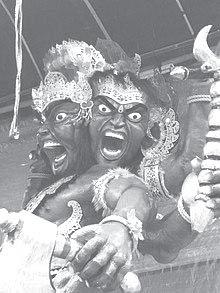
Nyepi has a special place in Hindu Balinese life. The silence allows them to reflect on their lives, assess their past deeds, and start the New Year with a calm mind and a pure heart. Although Nyepi is primarily a Hindu festival, non-Hindu residents also observe the silence out of respect to their fellow citizens.
The day after the Nyepi day, or the 4th day is known as Ngembak Geni or “Relighting the Fire”. Life returns to normal, businesses are opened, and social activities resume. Family and friends gather to ask forgiveness from one another and let go of the past. They also perform religious rituals called Yoga/Brata. Another wellknown ceremony is OmedaomedaninSesetan’s Banjar Kaja Community. It is a kissing ritual where non-married people are paired and kiss as part of the celebration.
On the 5th day, Ngembak Agni/Labuh Brata is performed to rejoice and spend the day outside. This a way to welcome the new days of the New Year.
On the 6th day, Dharma Shanti is a ritual of reading slokas and reciting ancient scripts of songs and lyrics. With Shanti, the Nyepi and the New Year festival come to a close.
Interestingly, in many parts of the Indian subcontinent, New Year festivals are performed on the same day as Nyepi. For example, in Maharastra, the festival is called Gudi Padwa, and in the province of Sindh, people celebrate Cheti Chand. In Manipur, the celebration is
called SajibuNongmaPanba, and in parts of Karnataka and Andhra Pradesh, there are celebration called Ugadi We happened to be in Bali at the beginning of the festival. Unfortunately, our departure flight was in the afternoon of the day before the Nyepi day, and we missed the Ogoh-ogoh parade.
As we were travelling towards the airport, the elderly Balinese taxi driver started talking excitedly about the Nyepi and Ogoh-ogoh parade and his recollection of the fun and excitement he had during his younger days. You could not help but get immersed in the excitement. He wished that we could stay few more days and enjoy the celebration. We wished too.
As the car slowly moved towards Denpasar airport, we could sense the fun and excitement that had already begun. As the car reached our destination, we wished the driver a happy Nyepi and New Year. He also wished back, and then said with a wry smile, “No income tomorrow”. We doubled the tip.
References.
• Rituals and Meanings of Nyepi Day in Bali: UNTAR, Tarumanagara University • https://en.wikipedia.org/ wiki/Nyepi • https://en.m.wikipedia. org/wiki/Ogoh-ogoh • https://www.indonesia. travel/us/en/event-festivals/Nyepi-balis-new-yearsday-of-complete-silence • https://bali.com/bali/ travel-guide/culture/Nyepibalinese-new-year/ • and others…
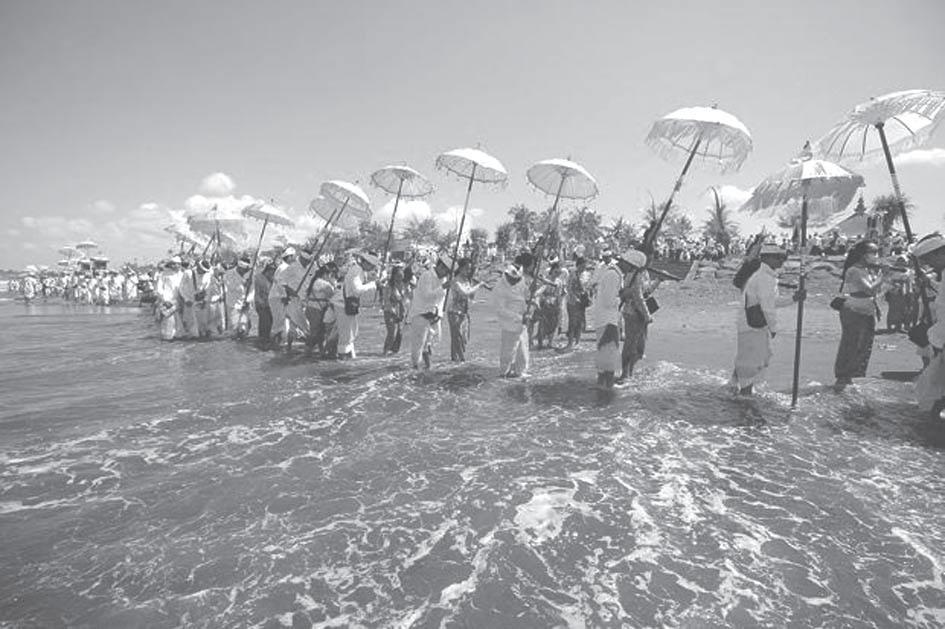
Reported by Mita Sinha, Chair, Puja Committee
Summer time is a fun time. People visit the temple more often and we see lots of kids coming in. It is a good experience for the kids, they get to learn about our culture and practices.
The first puja for the month of July was our monthly Shyama Puja. We had a number of families came to the temple for this puja.
On July 7, we had our annual Rath Jatra festival. On this day Lord Jagannath, Balram and their sister Subhadra were placed on a chariot and were taken for a ride. In recent years Ratha Jatra has been celebrated in some western countries also. At Ananda Mandir the deities of Jagganath, Balaram and Subhadra were brought out to travel on a chariot drawn by lots of devotees, accompanied with sankha, kansar, and dhak. Kids with their parents participated in this procession. This is as fun festival. Different types of snacks and drinks were for sale on our premises on that day. Everybody enjoyed this special event. After doing couple of rounds within our temple ground deities were brought back inside the temple. We had some dance performance by young kids that day. Then we had our Puja and Aarati and dinner.
On July 9, we had our Bipadtarini Puja at the temple in the morning. Ma Bipadtarini is prayed to help in overcoming troubles. This puja is done in the morning at Ananda Mandir. The tying of the red colored thread on the wrist is one of the significant customs of this puja. After the puja we all had prasad from the temple.
We celebrated UltorathJatra and Satyanarayan Puja on July 15. UltorathJatra marks the return of Lord Jagganath, Balaram and Subhadra to their home. A large number of devotees came to the temple on this day. This was a festival of fun and lots of kids came with their parents and participated in the festival. After the deities were brought inside the temple we had our Satyanarayan Puja. After the broto katha path we had Arati and Anjali. The evening ended with nice dinner.
The first puja for the month of August was on 8/3 on a Saturday, this was our monthly Shyama Puja. We had very good attendance for this puja. Summer month and good weather always attracts more people in the temple.
We also celebrated our India’s Independence’ day on August 20 at Ananda Mandir. Hoisting the American flag and Indian flag, singing national anthem of both countries, poetry reading, songs and marching with flags of both countries was a good celebration. Lots of kids participated in this program and it is an important activity for our next generation kids to learn and know about India’s fight for freedom.
On August 19 we had Rakhi Purnima and monthly Satyanarayan Puja at Ananda Mandir. Rakhi Purnima is also known as Raksha Bandhan is celebrated in all over India. On this day sisters tie the rakhi around the wrist of their brothers. At our Mandir we had our Satyanarayan Puja on this day. We all enjoyed the puja and dinner.
The last puja for the month of August was Janmashtomi. This day marks the birth of Lord Krishna. It falls on the eighth day in the month of Sravan in the Rohini Nakshatra, Ashtomi Tithi. At Ananda Mandir we collectively chant Lord Krishna’s name ten thousand times on this day. The temple remained opened from 9:00 am to 8 pm and devotees came in all day to offer their pujas and said their prayers.
The first puja for the month of September was on September 2, our monthly Shyama Puja, followed by Ganesh Chaturthi on September 7. Ganesh Chaturthi is one of the most auspicious days of this month. It involves welcoming Lord Ganesh into our home.
On September 17 we had our Biswakarma Puja. Lord Biswakarma is considered as the designer of the world. He created the holy city of Dwarka that was ruled by Krishna. He also created several weapons for Gods. It is an important day for craftsmen and artisan across India. Biswakarma is revered as the deity of architecture, mechanics, and craftmanship. People involved in this kind of profession offer prayers for progress and success in their work on this day. We perform this puja in the morning at Ananda Mandir.
The last function for the month of September was on 9/29, our Mahishasura Mardini. Durga Puja festivities started with Mahishasura Mardini program. A musical program describing Ma Durga’s act of slaying the asura (demons), happened on September 29 at 4:30 in the morning. The story was narrated during this program with songs and Chandi path, ending with Arati of Ma Durga. After the program ended, we had our grand breakfast.
Puja is an essential practice of a Hindu family. We perform different types of pujas at Ananda Mandir. We welcome our kids to participate in our puja activities and learn about our culture. Please come to the temple with your family and involve your kids to different activities.
Autumn is in the air. Durga Puja is around the corner. We will be starting our puja preparation soon. Come and volunteer for Ananda Mandir if you have time.
Ananda Mandir is a special place for us. You can feel at home if you participate in any of our puja activities. Everybody is welcome here
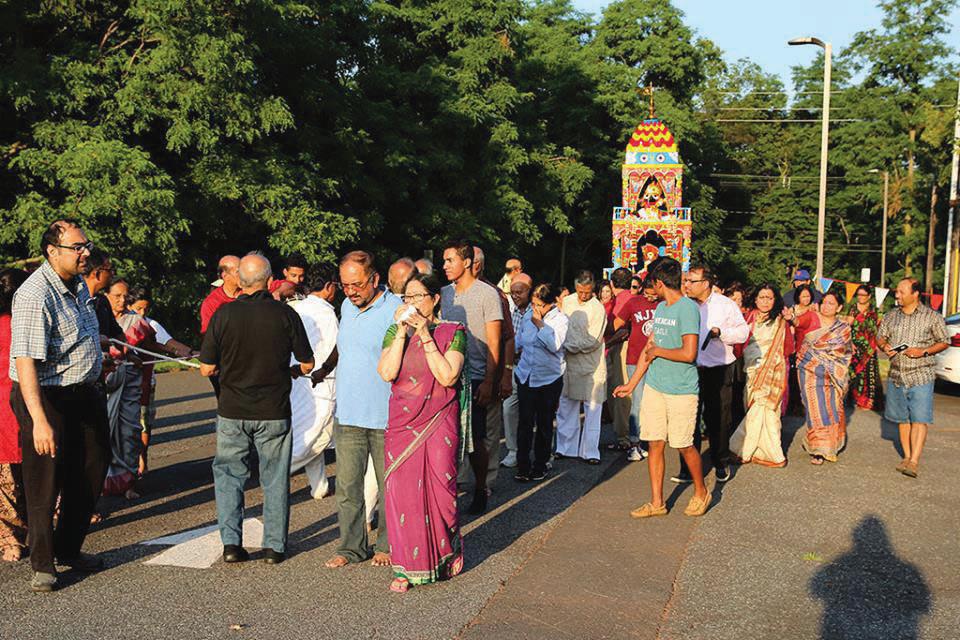
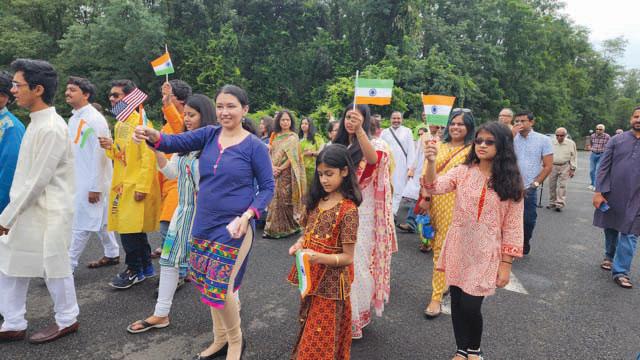
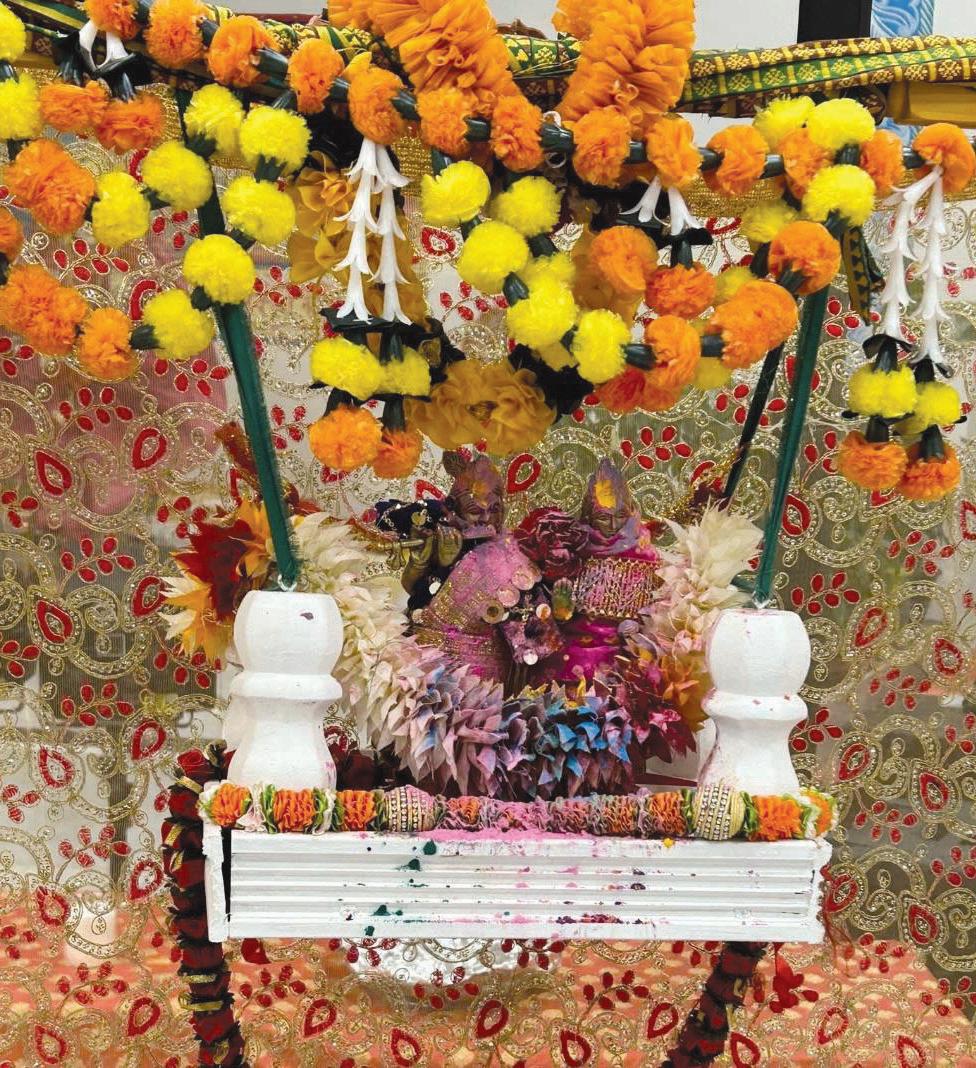
come and join us and be a part of this great organization. If you want to offer private puja please come and talk to the priest at the temple. Visit
our website www.anandamandir.org and you will find listing of all our upcoming pujas. Join us and become a member.
Reported by Sajal Mukherjee, Chair, Cultural Committee
With NABC, SATF, and several other cultural events in the tri-state, combined with an upsurge in social activities, there is hardly any room for more. Hence this year we decided to
go slow with our cultural presentations during the months of July, August and September. Despite that, we had three successful cultural events.
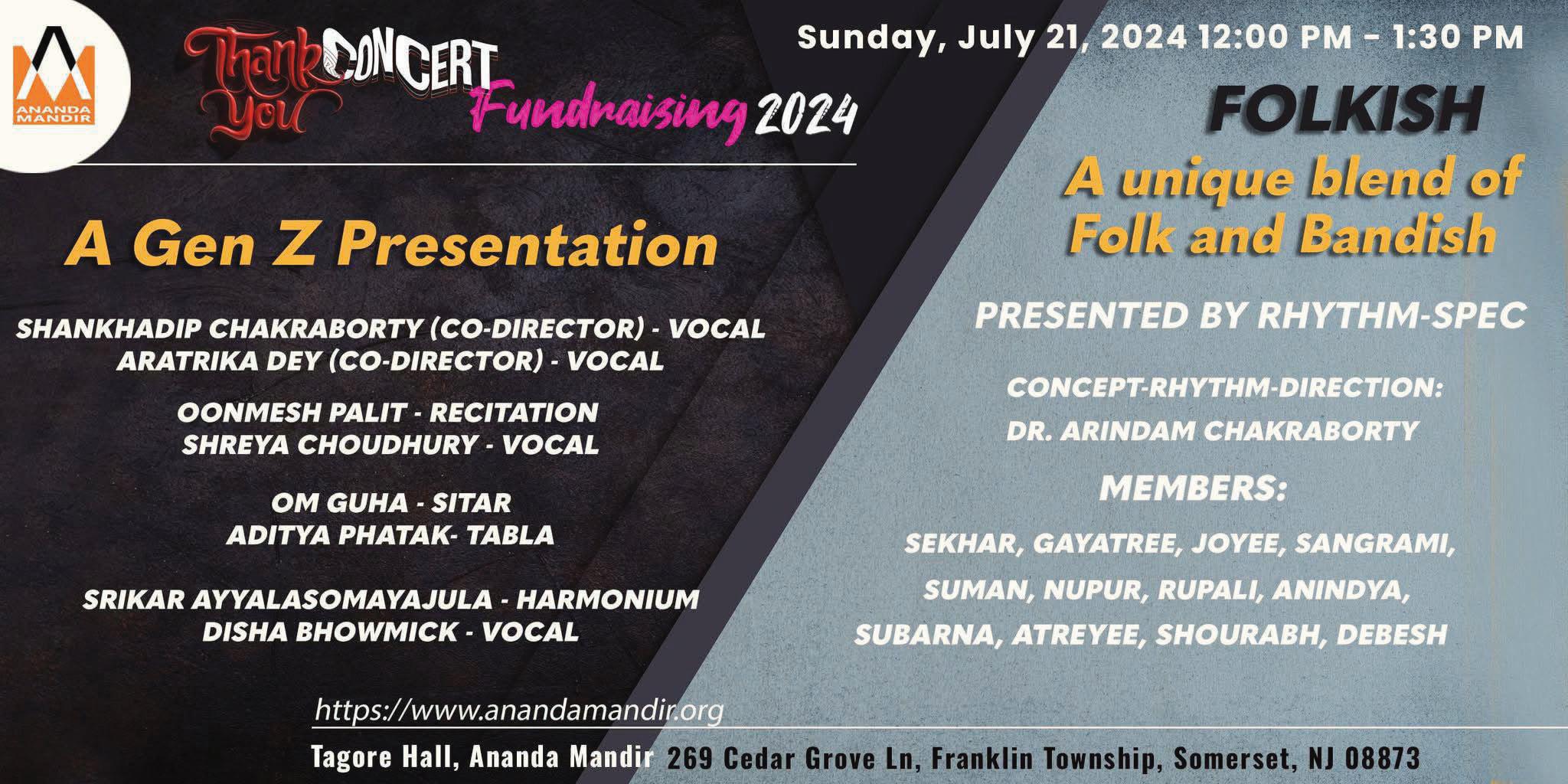
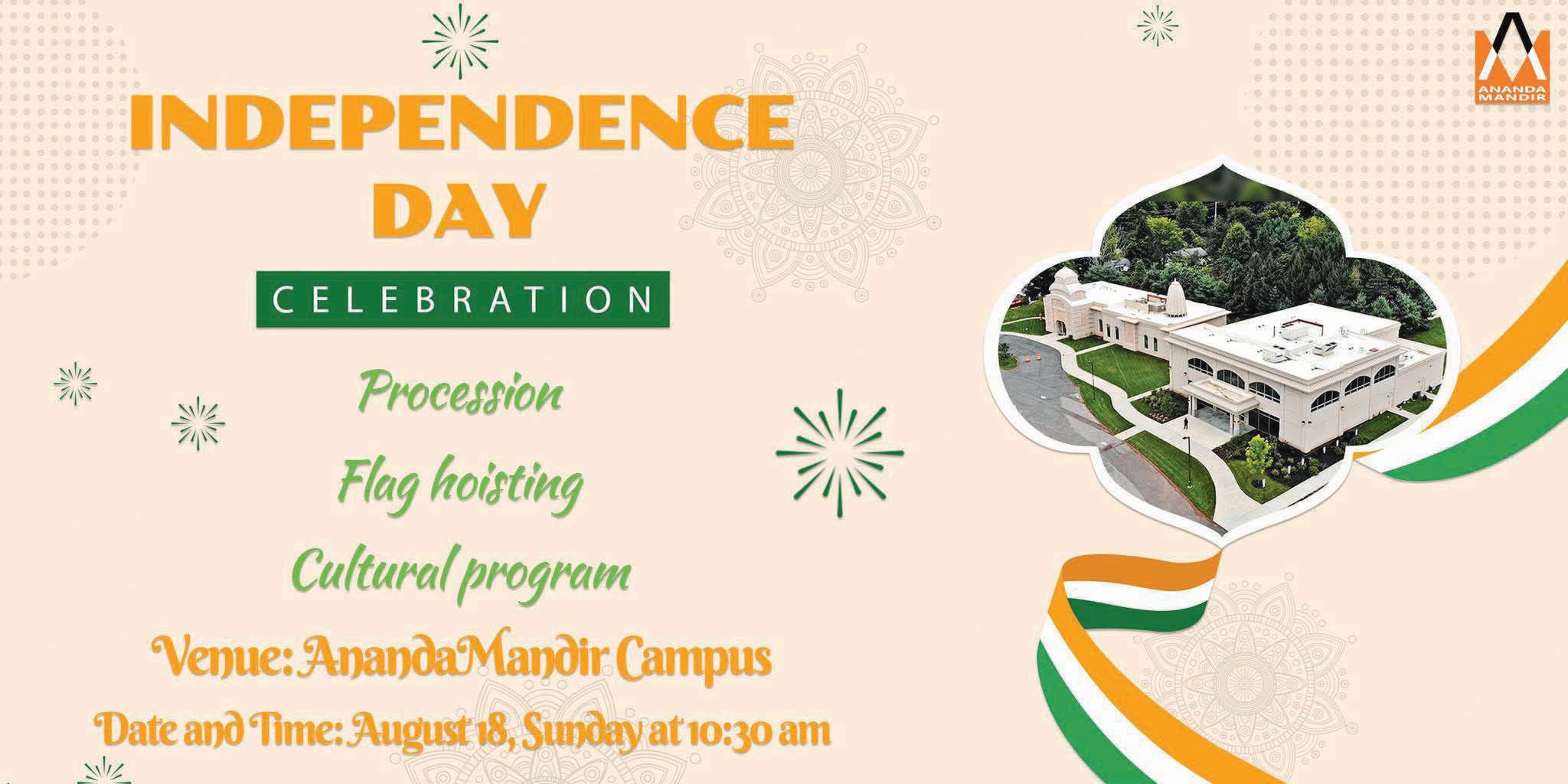
We hosted a music concert on the eve of the conclusion of 2024 fund-raising on July 21st. This concert had two segments. The first segment was conceptualized, co-directed and presented by our Gen Z artists led by Sankhadip Chakraborty and Aratrika Dey, supported by Oonmesh Palit (recitation), Shreya Choudhury and Disha Bhowmick (vocal), Om Guha (sitar), Aditya Phatak (tabla), Srikar Ayyalasomayajula (harmonium). The second segment, presented by Rhythm-Spec under the leadership of Dr. Arindam Chakraborty, was a unique blend of Folk music and Bandish. Other members were Sekhar, Gayatree, Joyee, Sangrami, Suman, Nupur, Rupali, Anindya. Subarna, Atreyee, Shourabh and Debesh.
On August 18, Sudipta Bhanja Choudhury, Shreya Choudhury, Arun Bhowmick, Dr. Dipak Sarkar and Biswabhai carried out our annual tradition of celebrating India’s Independence Day.
The second episode of Ananda Sandhya was held on September 6. Madhurima Choudhury presented Adhunik songs, while Sangrami Lahiri presented a classical vocal segment. Madhurima and Sangrami were ably supported on Tabla by Amit Das and Gokul Panda respectively. Our beloved Vice President Debajyoti Chatterji regaled the audience with stories from his recently published book – “One Immigrant, A Hundred Stories”.
“Mahisasur Mardini”, the musical program that heralds the soon-to-arrive Durga Puja to all Bengalaes, will be presented live on September 29, 2024 at 4:30 AM inside the temple. Bijoya Sammelini will be celebrated in Tagore Hall on October 26, 2024 with an Odissi Recital by Mitra Purakayastha and team, followed by a Hindustani Classical Vocal Concert by Supriyo Dutta and team.
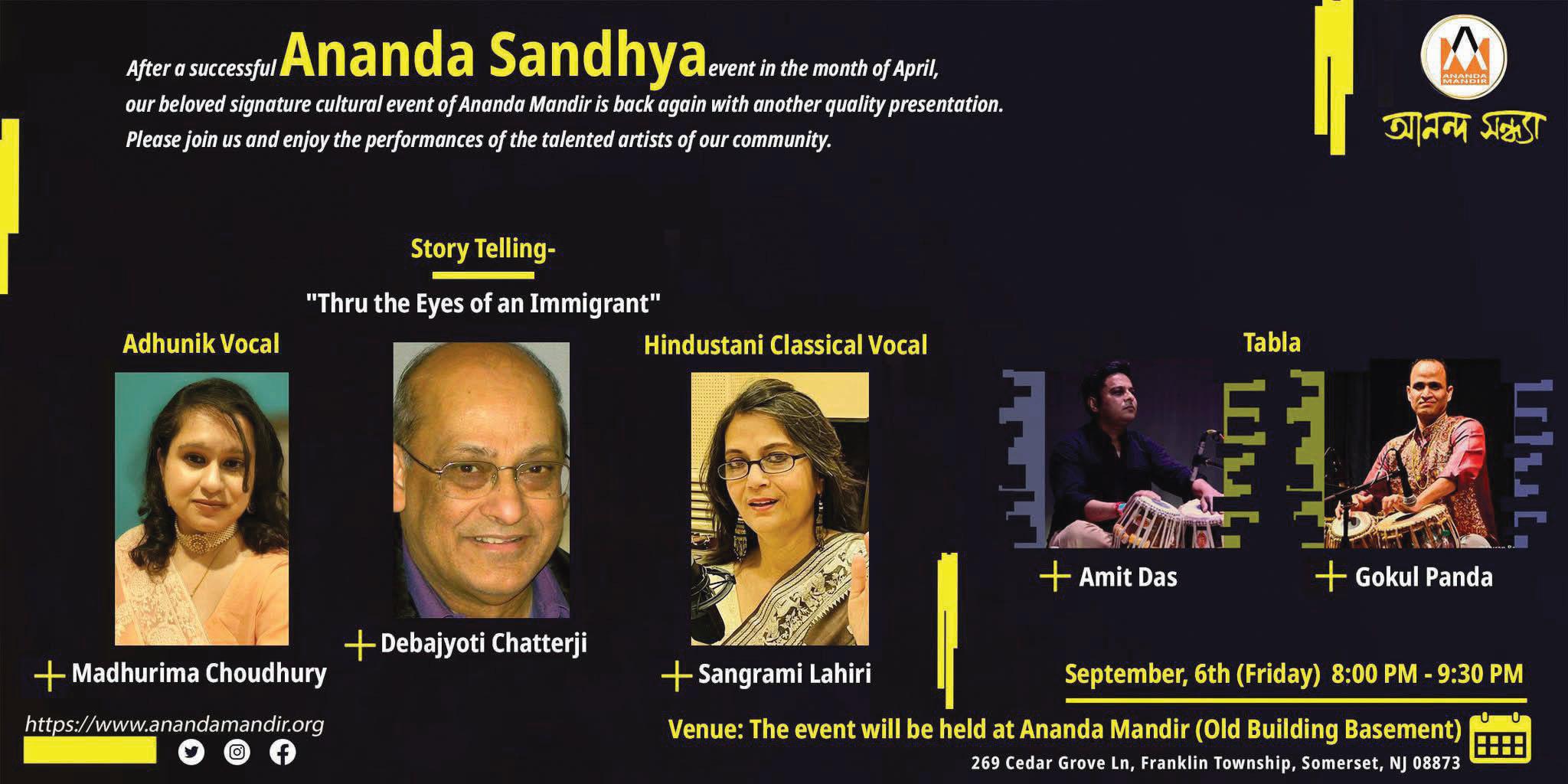
By Rahul Ray (Massachusetts)
These days Dr. Muhammad Yunus’s name is everywhere, be it on TV, real news media (New York Times, Washington Post, Boston Globe, and like), make-believe and fake news media (YouTube, Facebook, X, etc.), and in private parties and conversations among Bengalis from Bangladesh and West Bengal, India. Suddenly he has risen to a super-hero status to save the country of Bangladesh from pogrom and lawlessness. Yunus, the much-decorated economist, and Nobel Peace Prize winner was recently coronated as the head of an interim governing body before the elections to choose a leader who would form a legislative body and a legitimate government.
We humans often try to associate with a celebrity as if a part of the glory can rub off and transfer to a recipient. Therefore, associating with Dr. Yunus directly or indirectly may bear the fruit of second-hand glory. Hence, I decided to join the bandwagon. However, at the outset, it is to be said that my association with Dr. Yunus is neither personal nor professional. The only way to describe that relationship is ‘accidental’.
I learned about Muhammad Yunus’s work on microcredit to uplift poor people, particularly women in Bangladesh, nearly twenty years ago. I was not an economist then or now, but his work heightened my interest due to my idealism and leftist activities in my youth. In those days I, like many others, truly believed that social and economic justice for all was not merely a dream, it was achievable, and somehow, we could influence it with our political activism.
Of course, our dreams were rudely shattered.
Many years later I learned about Grameen Bank founded by Dr. Yunus giving micro-credits to poor people. I was thrilled to learn that providing small loans to havenots of society, particularly women pulled them, and sometimes the entire family by their bootstraps from abject poverty. In no time I became his ardent admirer. I was not far off in my assessment. In 2006 he was awarded the Nobel Prize in Peace for his work with poor peo-
ple in Bangladesh.
My interest in Yunus’s work was also a bit reflective, emanating from my knowledge of another Nobelist Rabindranath Tagore’s effort at social reform at his Zamindary/land owning in the then East Bengal, and present Bangladesh in the first decades of the twentieth century.
The similarities between their approaches are striking, but dissimilarities also exist. First similarities. Both identified people at the bottom of society, particularly women as the prime engine of economic upliftment and growth. Their mode of intervention was also strikingly similar. After winning the Nobel Prize in Literature in 1911 Tagore founded Patisar Community Bank at Patisar, a hamlet in the then East Bengal on the large piece of land owned by the Tagore family. He offered small credits to his subjects, mostly impoverished Muslim peasants with rock-bottom interest rates. History tells us that. Tagore successfully reduced poverty among many. He spearheaded efforts in distributing high-quality rice seeds and fertilizer to the peasants and introducing tractors to till the land which was otherwise difficult to plow with traditional ways involving bullock-driven langol (tiller). Later, Tagore, aided byLeonard Elmhurst, adopted the same model to help small handicraft artisans at Sriniketan near Shantiniketan, the site of Vishwabharati University, founded by Tagore.
Similarly, almost half a century later Yunus offered small credits with low interest rates through Grameen Bank, which he founded, to village women to buy, for example, goats and chickens to provide milk, and eggs, respectively, and meat. Furthermore, goats and chickens multiplied, and women, besides providing nutrition for the family sold extra milk, eggs, and animals for cash. Poor women, mostly from highly orthodox Muslim families quickly became small entrepreneurs.
Another sea change happened in the wake. Droves of women, inspired by the success of the micro-credit model who otherwise stayed home taking care of the family flocked to garment facto-
ries for real jobs. These factories have been the economic bastion of Bangladesh. This removed social sigma, and further uplifted their families. The ultimate result was a significant improvement in the economic health of the society and the country.
This model quickly became popular globally and several societies adopted it. This success also propelled Dr. Yunus into international stardom. The latest example is his inclusion as an advisor for social responsibility in the Global Olympic movement at the recently finished Paris Olympic Games.
Now differences. Although Tagore and Yunus were on the same track for social development the former never tried to expand his ideas beyond little villages under the control of Tagore family land ownership. As a result, the seminal work of Tagore on socio-economic reform and development has remained largely unknown, buried deep under his other achievements. In contrast, the latter adopted the hugely successful model nationally and later internationally.
The second difference is a bit subtle.Tagore was a deeply spiritual person. He sought spirituality in all his endeavors, including social responsibility. For example, he felt he was fulfilling God’s wish for economic equality between the sexes and racial harmony. Much of his writing in that period on social activism attests to this. In contrast, Yunus, a devout man, did not invoke, to the best of my knowledge, religiosity or spirituality in seeking economic justice for the poor.
Now, the ‘Accidental Us’ part of the title of this article. Here ‘Us’ is primarily Arjun, our son. Interestingly, ‘Us’ also includes a large Bengali community from West Bengal in the Boston area through the association with Prabasi, the nearly fifty-year-old Bengali organization. Prabasi, like similar associations in the US, hosts the annual Durga puja in the fall, Saraswati Puja in the winter, and Kabi Jayanti (celebration of poets) in the summer. It is also a years-oldPrabasitradition to publish a literary magazine in Bangla and English during the Durga Puja time.
The Prabasimagazine is a historical document tracing back to Bengalis from India
who migrated to this area in the early 1970s. They brought their unique culture of music, dance, theater, literary endeavors, love for food, and reverence for Rabindranath Tagore’s works. We moved to this area in the early 1980s. Within three years we participated in two dance dramas, sang innumerable songs, and recited poems – all Rabindranath’s creations.
The year was 1998. Dr. Amarya Sen, a Bengali from
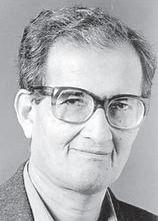
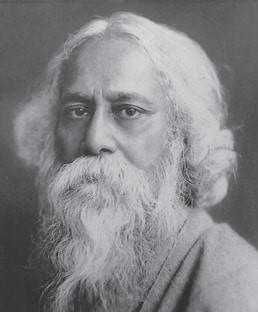
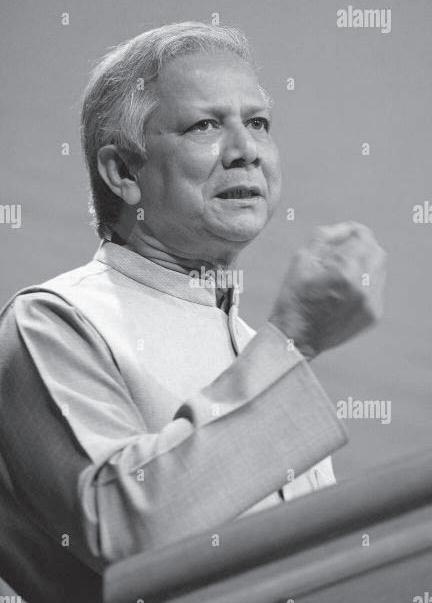
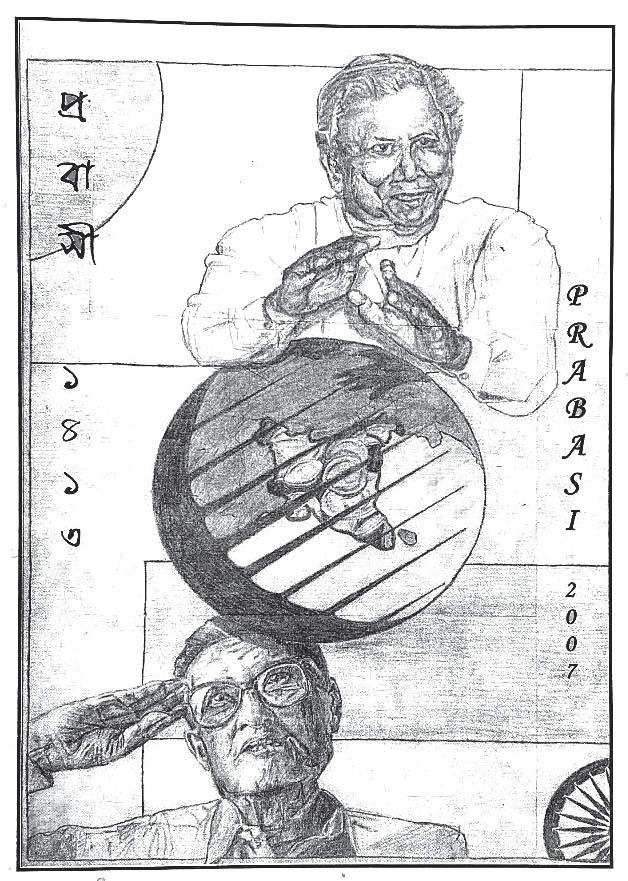
Magazine Cover
India, who owes his name to Tagore, and who grew up in Shantiniketan and schooled at Vishwa Bharati University won the Nobel Prize in Economics much to our pride and glee. Interestingly, Sen’s work, which won him the Nobel Prize, involved uplifting poor people from social
and economic stagnation. Then came 2006, Yunus, another Bengali from Bangladesh, was awarded the Nobel Prize in Peace, furthering our pride and joy as Bengalis.
In 2007, Swapna, my wife, and Arjun (Babu)’s mother, was the editor of the Prabasi magazine. She wished to
By Basab Dasgupta (California)
Ilike bike or more precisely the fantasy of riding a bike. I have never been on a motorcycle, not even as a passenger and certainly not as a biker. To tell you the truth I am always a little scared of bikes. The possibility of an accident and resulting injury are the first thoughts that come to my mind when I look at a motorcycle or even a scooter. I also worry about the heavy bike simply toppling over me while I am trying to get on or off it.
I had not seen too many motorcycles on the streets of big cities in India when I was living there. It is probably because of the traffic congestion which does not allow a smooth carefree ride. Scooters, which are less expensive and easier to navigate in a crowded street are more popular, especially in and around Delhi area.
After coming to the USA, I have seen the macho side of the bikers. They always seem to dominate the roads with high speed and roaring noise to command attention if not admiration. They have emerged as a rebellious counterculture segment of the society where sex and drug rule, symbolized by black leather jacket and blue jeans. It also seems to be a male-dominated brotherhood although there are female bikers (reportedly, about 10% of them); the women in these groups are usually envisioned as companions to the male bikers, holding them closely and affectionately around the waist from the back and once again enhancing the masculine sexual image.
Although the concept of a motorcycle in providing fast transportation was originally invented by the Daimler Corporation in Germany, the US company Harley-Davidson became the largest manufacturer in the world after World War II followed by the Europeans and the Japanese. In fact, motorcycles have earned the nickname “HOG” (originally introduced as an acronym for “Harley Owners’ Group”). Groups like “Hell’s Angels” emerged who used Harley exclusively in their activities. Although such biker groups are often associated with an image of a violent criminal gang, they can also be valuable assets in helping during natural disasters and in political campaigns.
Hollywood has exploited this appeal of bikers in several hit movies starting from “The Wild One” starring Marlon Brando to “Easy Rider” and others. The song “Born to be Wild” by the rock group Steppenwolf can be called the anthem of motorcycle lovers. Bikes have also been used extensively in more recent action-packed movies like the “Mission Impossible” series.
Surprisingly, California traffic rules allow a biker to steer his/her motorcycle through the narrow space between two cars in adjoining lanes – another scary proposition to me. I must be always on the lookout for a biker zipping past me to make sure that I do not make any sudden lane change and literally blow the biker away.
Motorcycles are widely used by lawenforcement officials. One of my everpresent anxieties during driving on freeways is the possible sight of a policeman on a bike chasing me with his siren blazing and lights flashing. Motorcycles are also used in western countries, not only by cops but also by secret police or bodyguards escorting dignitaries, especially when they are on a motorcade route amid cheering onlookers. Historically, bikes have also been used in the frontlines during World War one for mostly communication purposes.
Acrobatic performances using a motorcycle have their own unique appeal. The performance of a biker going on a motorcycle repeatedly around the inside of a spherical globe at a very high speed offers very thrilling entertainment in many circuses. In the USA, Evil Knievel created his own legacy by jumping over large distances, typically over several buses or other vehicles, in a motorcycle on numerous occasions.
However, I am surprised that the culture of owning motorcycles has not caught on among the public on a much wider scale. Even motorcycle racing is not that popular compared to bicycle or car racing. It seems that whenever there is a spike in gas prices, commuting by motorcycle becomes popular. In the big cities of India, it certainly makes sense to learn how to bike, not only for fuel economy but also for maneuvering through narrow paths in traffic congestions. I would have also expected bikes to be popular among the highly individualistic younger generations who seem to prefer items for their exclusive use and are averse to a culture of group-sharing. Popularities of devices like I-pods, I-phones, single-cup coffee brewers, personal TVs etc. attest to this mindset.
The most annoying aspect of a motorcycle is its noise. I certainly do not want to live in a neighborhood where that “vroom vroom” sound of bikes” pollutes the tranquility of the neighborhood day and night. A happy solution to all these issues may be just around the corner – an electric motorcycle which is much quieter and more fuel economic than its cousin – a gasoline-powered bike. Such motorcycles are already available, but the price is perhaps a little too high for mass appeal. What could be more attractive to a millennial or any other person for that matter than a quiet fuel-efficient fast individual transportation?
E-bikes or battery powered bicycles, costing about $2000-3000 have recently become very popular in this country, especially among teenagers. While they are perfect for going to school or grocery store or neighborhood park, they have limited driving range. Also, the traffic rules have not been updated to provide specific rules about where and how one can ride these E-bikes, thus raising some safety concerns.
What appeals to me most is an entirely different aspect of driving a mo-
torcycle which is the fact that it provides a platform for romance. This should be especially relevant in a conservative country like India.
Just think about it. If you are riding a bike with a woman friend, then it is just the two of you in very close proximity with the girl holding your waist very tightly. You have complete privacy in any communication even though the ambient noise might require that it must be carried out somewhat loudly. There is no fear of being seen by someone who would start gossip; you would be long gone before any observer has a chance to look closely and identify you. In addition, there is a feeling of freedom and adventure and the dream of a journey into the future leaving everything behind. From a practical point of view, traveling within the city from one point to another for the purpose of a romantic tryst is certainly faster and more convenient than going by public transportation or even private cars.
Despite all these romantic opportunities I have not known many young couples romancing during a bike ride. Not only that, even in Bollywood or Tollywood movies there are not many examples of such romance on silver screen.
There are two romantic scenes of bike rides (with an accompanying song, of course) from Indian movies made life-long impressions on me. The first one was the song “Ei path jodinasehsh hoy.....” from the movie “Saptapadi” featuring Uttam Kumar and Suchitra Sen on a motorcycle. I saw the movie with my parents when I was probably twelve or so. I remember my mother making some comment to the effect that “joto sob nyakami”. The scene was my awakening into the phase of teen-age romantic fantasies. I knew that such a ride with a beautiful girl was not an accepted norm in our Bengali society during the late fifties, but nonetheless it made a huge impact on me, especially when Suchitra Sen says “...na, tumiee bolo”. It was almost a romantic submission - a youthful fantasy!
The second song was “Zindagi ek safarhaisuhana....” from the movie Andaaz and Kishore Kumar and Lata Mangeshkar lent their voices to the romantic pair Rajesh Khanna and Hema Malini. The year was 1971 and I was going back to Calcutta to get married. I flew Kuwait Airlines because of their low fares but Kuwait took me only to Bombay, arriving in the morning. My domestic flight from Bombay to Calcutta was in the evening which meant I had almost ten hours of layover. I spent most of that time simply sitting in the waiting room with occasional visits to the restroom and restaurant and dreaming about my wedding and subsequent married life. The song and the associated movie clip played over and over on the TV monitor of the waiting room. The catchy tune got embedded in my head and the lyrics deeply resonated in my heart. Zindagi indeed seemed to be a suhanasafar to me that day and I was glad that I was getting married to my dream girl at such a young age because “yahan kaal keyahogakisnejana”.
Yes, I like the idea of riding a motorcycle whether for romance or promoting a macho image even though I doubt that I will ever try it myself.
continue from page 11
highlight the recent success of Bengalis in winning Nobel Prizes in the magazine and requested Babu, who showed an early flair for artistry, to draw/paint a cover for the magazine. He happily agreed. Swapna did not give him any instructions about the content of the cover except it had to deal with two Nobelists in any form shape or fashion.
Babu was staying in his college dorm those days and did not give us a clue what he was doing about the magazine cover. About a month later he came home with a large pencil sketch as a draft.
Swapna and I were completely overwhelmed by the thought, effort, care, and love he had put into that picture. A qualification is required. Although Babu was born to Bengali Indian parents and was exposed to Bengali culture, particularly Rabindranath’s literary and musical creations it was difficult for us to conceive that he would develop ‘love’ for anything Bengali.
And it is love. The sketch is extraordinary. It has flags of Bangladesh and India in the background, and portraits of Drs. Yunus and Sen are in the foreground. Most interestingly and unusually the portraits are highly animated. A smiling Yunus has his hands gesturing at an assuring stance. On the other hand, looking upwards with a solemn face, Amartya. Sen is saluting, perhaps his successor. The middle of the sketch contains a map consisting of India and Bangladesh. Most interestingly the picture also shows coins tossing down as if to emphasize the economic interest of the duo. The sketch is a labor of love!
Light touches of green and saffron were added to the magazine cover to represent the national identities of the two nations.
The framed sketch is prominently displayed in our living room. Drs. Sen and Yunus are easily recognizable from the portraits that Babu has drawn, yet not too many visitors to our home have commented on this extraordinary picture. Perhaps these Nobelists are not Hollywood or Bollywood personalities, and not well-known beyond academic circles. However, the recent turn of events in Bangladesh may change the scenario if Dr. Yunus is to be successful in bringing peace and harmony to Bangladesh or if he fails in his mission.
Reported by Pradip R. Das (New Jersey)
GSCA hosted its Annual Picnic on Saturday, July 27th, at Reichler Park, Monmouth Junction, NJ. Members and members’ friends, adults and children of all ages, gathered at this beautiful site of lush green meadows surrounding the picnic spot. The picnickers were treated to Bengali jalkhabar (snack) items with hot beverages for a late breakfast. Later in the day, for lunch, typical grilled picnic items were made and served in abundance. Varieties of hot and cold beverages were available all day.
This day-long event was filled with many fun-filled activities to keep both adults and children occupied and entertained all day. Games for all age groups including spoon races, tug-of-war, three legged races, and musical chairs were organized. Prizes were given out. Besides the favorite pastime of “adda”, adults also joined in antakshari, sharing jokes etc. Some were seen playing volleyball, badminton or soccer. Some even ventured out on paddle boats on the lake, making merry of the beautiful summer day.
During wrap up time, members joined in the clean-up activities. One could not help but observe the camaraderie and true sense of teamwork in all activities. The day seemed to go by fast with the attendees spending a perfect day with savory food, great company, music and many sporting activities. This event also saw many new faces/members who have joined the organization in 2024.
Preparation for the biggest event of the year, Durga Puja celebration on October 19 & 20, is in full swing with online registrations going on since mid-August. All the main facets of organizing a community event of this magnitude are being implemented. These include, but not limited to, proper coordination with school management, setting timelines for different activities such as pratimaset up and decoration, puja and dinner preparation, registration desks and vendor stalls set up, recreational and kids’ activities, stage set up and sound system, stage management etc. The main focus, as usual, is to ensure that an adequate number of volunteers are available and properly assigned to help with the smooth flow of each activity.
This year GSCA is hosting, as its anchor artists, Richa Sharma on Saturday, October 19th and Poushali Banerjee and her band on October 20th. In addition, a GSCA in-house program involving children, and items with local performers are in preparation.
GSCA is ready to welcome Maa Durga!
For several years, GSCA has been making concerted efforts to expand its philanthropic activities in ways that are having greater impacts on communities and individuals. Most notably, currently GSCA’s scholarship fund is supporting 40 students who are continuing their studies in Medical, Nursing, Engineering and other undergraduate programs in India. The students that are selected for support by GSCA are supported through their entire curriculum until they graduate successfully. Additionally, GSCA provides a one-time scholarship to 6 Plainfield High School graduating seniors every year.
New students sponsored in 2023 - Seven (female 4, including one disabled and male 3).
Courses attended by these students include 3 MBBS, 1 Nursing, 2 BSc in Physics and Maths respectively, 1 PG in Clinical Resources & Regulatory Affairs.
Existing students (in addition to 2023 numbers) - 40 (25 through Mukti Foundation and 15 with Sinchan). Courses pursued by these 40 include 18 in MBBS, 6 in Nursing, 1 in Pharmacy, 8 in Engineering and 7 in BSc/MSc.
Philanthropy committee members, during their visits to India, interact with existing and newly supported students. They also search for potential future scholarship recipients and work with our partners in Kolkata who facilitate the implementation of our program there.
In addition, GSCA’s youth volunteers organize snack stalls at various GSCA community events and donate all sales proceeds to philanthropy. What a marvelous and encouraging impact GSCA’s philanthropic efforts are having on the youth!
The lives of many young people, and their families as well, have been altered profoundly as a result of GSCA’s benevolence.
Reported by Arundhati Sanyal (New Jersey)
Maitree Association of America (MAA) has had a vigorous summer with ongoing preparations and rehearsal for Durga Puja having begun in full swing. In addition, the members continued to showcase their talent in a variety of fields, Maitree Association of America _ MAA participated and became champion in AntakshariContest during the Saraswati Puja of Somerset Bengali Association. MAA team also championed in the India Independence Day Table Tennis tournament organized by Prosmash on August 17 at Cresskill, NJ. We held our Annual Picnic on Sunday, August 4 at Mercer County Park. It was very well-attended with fantastic food and games for children and adults. Women’s Forum had table of goodies like Pani Puri, Boondi, Brownies that were much appreciated and helped raise funds for philanthropic activities.
MAA philanthropic initiatives have begun to develop and show fruition. MAA has sponsored the education of a cohort of tribal girls at a school in Ghat-
sila run by Bharat Sevashram Sangha. MAA has also taken up the responsibility and sponsored the education of two under privileged nursing students from rural West Bengal through Bharat Sevashram Sangha.
In light of the recent heinous crime committed against a junior doctor in Kolkata’s R.G. Kar Hospital, Maitree Women’s Forum initiated and organized in conjunction with other organizations such as Krishnaa Foundation and Medha-Kallol a protest march held in Edison on August 25. A number of NJ based organizations attended the Protest that was successful and peaceful.
Looking ahead to the fall, Sarbojonin Durga Puja of MAA will be celebrated on October 19 and 20 at Hammarsjkold Upper Elementary School, East Brunswick. Very popular artists of Kolkata, Sourendra/ Soumyajit will perform on Saturday, October 19 and Lagnajita will perform on Sunday, October 20. There will be a variety of local programs and member engagement activities as well.
For severalyears, Ananda Mandir has organized blood donation drives for American Red Cross. The most recent drive was held on Tuesday, August13, 2024 with good results. Once again, Tagore Hall was the venue for this community service provided by Ananda Mandir. Doors opened at 2 pm and closed at 7 pm. Next blood collection date will be announced soon.
Please contact Utpal Sengupta (Chair, Community Services Committee) if you are interested in donating blood or have any questions. He can be reached at usengupta2@gmail.com
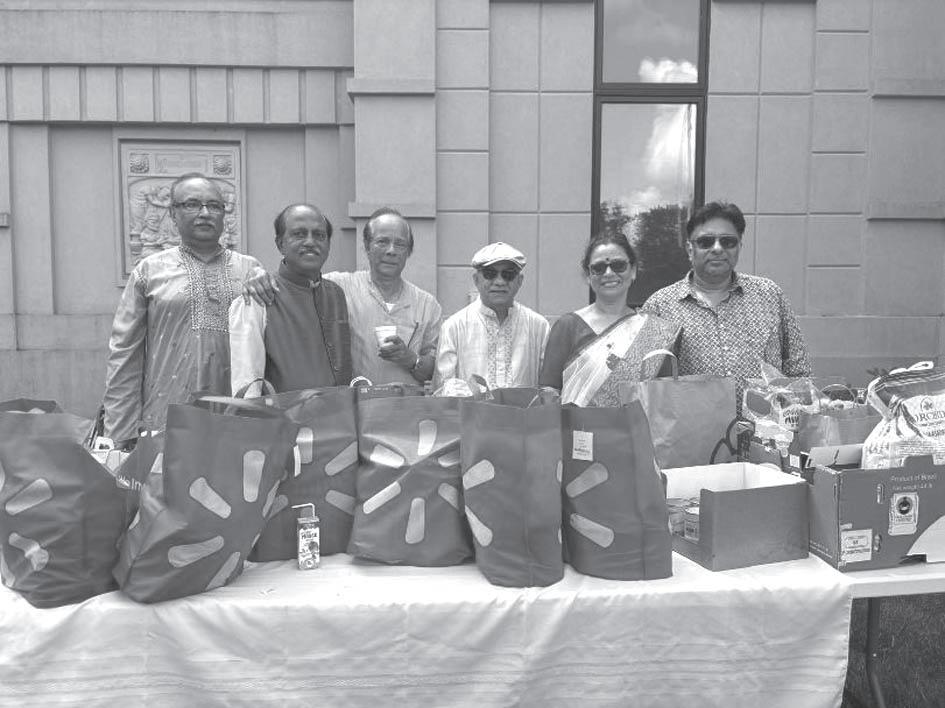
We organized a food drive on the occasion of the celebration of India’s Independence Day. On that day, we collected over 150 pounds of canned and dry goods. This was a record-breaking food collection for food drive! Franklin Township Food Bank received the delivery with much appreciation. Our thanks to Sudipta Bhanja Choudhury for organizing this successful drive.
By Mandira Chattopadhyay (Ohio)
Whenever the topic of untouchability comes up, I am instantly drawn to the dance drama “Chandalika” by Rabindranath Tagore that he wrote in 1933. Tagoreattackeduntouchabilityasinhuman and consideredthat asanevilthathadcreptintoanotherwiserationalsystemofcastehierarchy. Untouchability is an ancient malaise of Hindu religion, society and culture. Beginning with the Vedic period four classes in the society existed: Brahmin, Kshatriya, Vaishya, and Sudra representing knowledge, power, wealth, and menial labor respectively. Untouchability belongs to the lowest class, Shudra, or even worse.
In Chandalika Tagore presents Prakriti, an untouchable girl as the protagonist, and attempts to elevate this marginalized character to one of an illuminated and transformed human being. The Buddhist monk Ananda is the one that elevates her to this level. Prakriti flaunts the stringent Hindu scriptures and constructs her own identity by defying the grossly inequitable constraints of her religion, caste system, and society. Her mother, Maya keeps reminding her that she belongs to a Chandal’s family so nobody should touch her –“Chhuona, chhuonachhi, O jeyChandalinirjhi …” and that she can never pursue her illusory pursuits. But Prakriti is determined to contradict the discourse of untouchability.
By addressing the theme of untouchability through this dance drama Tagore makes an extremely bold socio-political statement against the discrimination if so called untouchables. In the dance drama Prakriti argues that she has been exalted by Ananda to identify her real existence as a bona fide human being far from being untouchable. Ananda’s words keep reverberating in her mind. “Give me water! (Jal Dao)”
Mulk Raj Anand wrote the novel “Untouchable” in 1935 in which he followed the events of one day of a young untouchable man. Anand was moved by the horrible plight of the untouchables, how they were separated from the rest of the society and discriminated against.
The incidents reported in the novel of the India of the mid nineteen thirties seem unchanged even to the present day. Very recently a nine-year-old Dalit boy was beaten to death by his teacher for drinking water from a pot meant for upper caste teachers.
India’s concept of rankings was originally known as varnas. From the lowest to the highest they were: Shudras the bearer of burdens, the Vaishya the merchant, the Kshatriya the warrior, and above all the Brahmin, the priest, the one nearest to the gods. Unmentioned amongthe original varnas were those deemed so low that they were placed beneath the Shudras. They were living out of the afflicted karmas of the past; they were not to be touched and some not even to be seen. Their very shadow was a pollutant. They were outside the caste system and thus outcastes. They were the Untouchables who would later come to be known as Dalits, who found themselves among the nation’s most marginalized citizens. In some parts of India, the lowest class of people were to remain a number of paces from any dominant caste person while walking out in public. A person in the lowest subcaste in the Maratha region had to “drag a thorny branch with him to wipe out the footprints” and prostate himself on the ground if a Brahmin passed, so that his foul shadow might not defile the holy Brahmin.
Touching or drawing near to anything that had been touched by an Untouchable was considered polluting to the upper castes and required rituals of purification for the high-caste person following this misfortune. This they might do by bathing at once in flowing water or performing Pranayama breaths along with meditation to cleanse themselves of the pollutants.
A significant number of Dalits continue to find themselves in occupation shunned by others, such as the disposal of dead animals and cleaning sewers. The Dalits were not allowed to drink from the same cups as the dominant castes and allowed inside Hindu temples
One Untouchable leader,
the late Dr. B.R. Ambedkar, was also able to use the British/nationalist conflict to introduce policies that improved Untouchable access to education and government jobs and provided for constitutionally guaranteed proportional legislative representation. The results have fallen far short of Ambedkar’s dreams, but political parties are obliged to pay competitive lip service to Untouchable interests, and a new generation of Untouchable youth is now sufficiently well-educated to be bitterly aware of the glaring gap between promise and performance. It is this generation that has introduced a new term for Untouchables - Dalits (the oppressed) - and a protest movement that often consciously echoes the themes and symbolism of Black America’s revolt. Meanwhile, Gandhi popularized ‘Harijan’ or ‘children of Hari,’ Hari being is the name of a central Hindu god.
But after 1974, when a militant anti-caste movement led by the Dalit Panthers (inspired by the Black Panthers) was crushed by rightwing Hindu political parties working for the state, Dalits ditched Gandhi’s benevolent jargon. For being linked to a Hindu god meant only more Hindu bondage. They went with ‘Dalits’ to oppositely assert reconstitution and, presumably, also give the finger to its real meaning. The Indian graphic novel “Bhimayana: Experiences of Untouchability “was published in 2012. This book charts the life if Bhimrao Ramji Ambed-
kar who campaigned for equal rights and an end to social discrimination towards Untouchables.
Historically, Dalits were reduced to performing jobs caste Hindus found polluting. They handled dead people and animals, soil, and waste respectively as cremators, cobblers, potters, gardeners, sweepers, and scavengers. Those who farmed were landless and indentured. It is well known that marginalized groups such as the Dalits and the Adivasis are disproportionately concentrated in skilled and semi-skilled occupations. Specific types of jobs are largely linked to caste identities particularly in the case of the lowest of the castes, the Untouchables.
Many Untouchables still perform menial jobs that are traditionally considered polluting or defiling. Although the practice of untouchability has been constitutionally banned since the passage of the Untouchability act it constitutes in certain forms not only in private social interactions, but also in the public sector. In private social life, a majority of those who are involved in garbage collection and disposal as well as the cleaning of public places belong to these communities. The mindset prevalent among the upper castes is that people belonging to the lower castes are physically and/or ritually unclean and therefore they should not be allowed to enter the kitchen (a sacred and clean place) or use the utensils that the household members use for consuming food. The do-
mestic workers employed in homes belonging to lower castes are usually allowed mop or swipe the floor or clean the bathrooms but not allowed to cook food or wash the kitchen utensils. It has also been found that many, if not all the workers performing such tasks belong to the lower castes.
Formerly known as Untouchables, Dalits are the lowest group of India’s millennia old caste hierarchy. So impure are they regarded by the four main castes that in fact Dalits are in fact looked upon as “outcaste.” Those who fall outside the caste categories they have been traditionally tasked with menial jobs like leather work and normal scavenging and are perceived to be unclean and even their presence or touch is seen to be polluting.
The motion of “purity and pollution” are the ideas that despite the spread of education and the advent of modern lifestyles, tend to stick and prey on religious and social insecurities. Social change is inevitably slow and necessitates a change in the political, economic, social and cultural environment. Thus, in turn, require the economic, social and cultural evolution of the Indian landscape has seen many of the traditions withering away or facing persistent from modernity and rationality. Notwithstanding the likelihood of the under-reporting of the practice of untouchability, most of the population seems not to indulge in this practice. This is an encouraging sign.
Ananda Mandir held its Annual Fundraising Lunch on Sunday, July 21. The event started at 11 am with a meet-and-greet period. Snacks were served to facilitate socializing among the friends. At noon, a short welcoming address was given by our president, Anjan Lahiri. A highly entertaining cultural program was presented soon thereafter to the assembled donors as our token of appreciation for their sustained support. Details of the cultural program can be found on Page 9 under Cultural Committee report.
We will be winding down our Annual Fundraising Campaign before the Durga Puja festivities begins. We are within striking distance of our goal of $250,000 collection this year. If you have not made your annual donation yet, please mail your check to Ananda Mandir before we close our campaign account!
The Dragonfly, a collection of short stories by the author Vishnupriya, presents a diverse cast of characters navigating complicated situations and searching for meaning in their experiences. Published in 2024 by Notion Press (and available in the US from Amazon), The Dragonfly’s motley crew of diverse characters come from all backgrounds and walks of life, yet each person - young or old, single or widowed, rich or poor - faces internal or external obstacles that threaten their wellbeing. From the whimsical tale of a long-necked boy finding a short-necked girl “(Necky and Neckless”) to the tragic story of life-changing loss (“Fixing Things”), the stars of these stories stumble upon both ordinary and extraordinary hurdles in their life journeys. I found myself moved in unique and powerful ways by the stars of these twenty-two tales, as they faced the ultimate question: would they stumble and fall on the hurdles of life’s journey, or would they learn to imitate the dragonflythat seemingly magical being that can adapt, change direction, and ride on the winds of change?
The ordinary is reframed to become extraordinary in Vishnupriya’s stories. On the surface, their situations are typical and familiar: a Ma fearful of what can happen when her teenager is finally able to drive,
Review by Kooheli Chatterji (New Jersey)
Editor’s Note: Vishnupriya is well known within the local literary circles, “The Dragonfly – A Bunch of Short Stories” is her first book. It has attracted much attention among the members of the Ananda Mandir community.
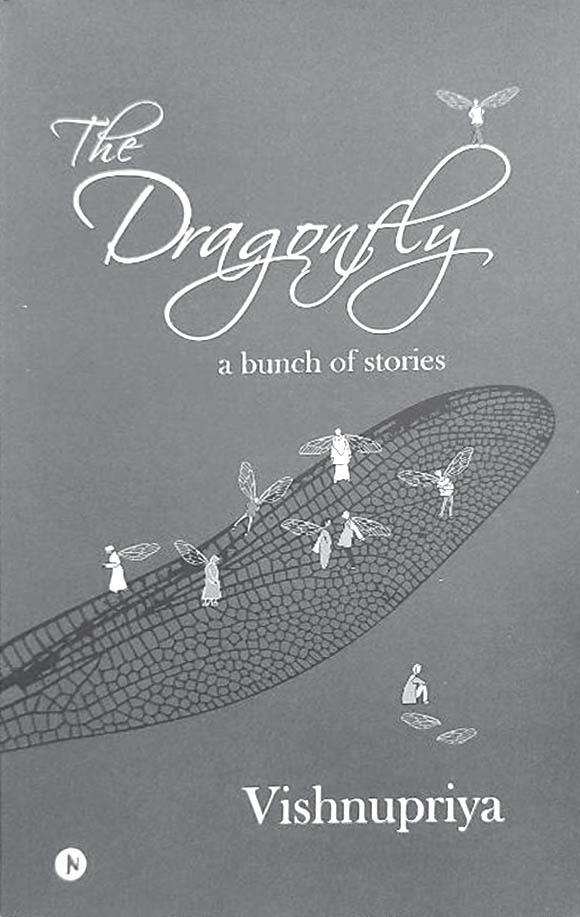
a Dadu asleep without his hearing aid, a homedweller so attached to his appliances he names them. Yet what is happening inside the minds
and hearts of these stories’ heroesthe disoriented yet chillingly clear parent in “The Fog,” for example - is what determines whether they will fall - or fly. In this way, the rich inner lives of these characters reveal even the most humdrum of life situations to be potentially full of meaning. It is not what happens to us thatmatters, Vishnupriya suggests, but how we react.
Vishnupriya’s creativity is impressive in this collection, and we see it on full display both in her unique plot designs and clever character choices. The unexpected happens often, as do unpredictable twists and rich endings. After reading the first three stories in one sitting, I realized this was a book that was best savored slowly. While we are only with the veteran of “After the Blast” while he follows his sleepwalking girlfriend for three pages, they are three pages that stay with you. As all of the stories offer this type of enchanting opportunity for reflection, the collection is indeed powerful.
Giraffe-like males aside, these tales do not retreat from some of life’s most difficult challenges. This cast of characters face loss in a myriad of ways: abusive relationships, mental health challenges, widowhood, and loneliness. Some experience dark moments, and all of them face their own doubts and uncertainties, worries and anxieties. Yet, even in the face of these potentially life-altering situations, they are reminded somehow of their humanity - through a conversation, a gesture, a meal - and thus reminded of the power of hope.
Readers who enjoy short but thought-provoking reads and original plots will appreciate The Dragonfly, and they will inevitably appreciate Vishnupriya’s facility with language. The 2019 winner of the Gayatri GaMarsh Memorial Award for Literary Excellence, Vishnupriya is to be commended for her remarkable storytelling skills and powerful creativity. As one of her own characters in this book comments, albeit on a different topic, these tales do more than just tell stories to pass the time: they “bring a little more meaning into a life touched with so much pain but also uncommon beauty.” If, like the dragonfly, we are open to finding deeper meanings in ordinary troubles and willing to look at others with love, we, too, may flourish and grow.
ADVERTISEMENT

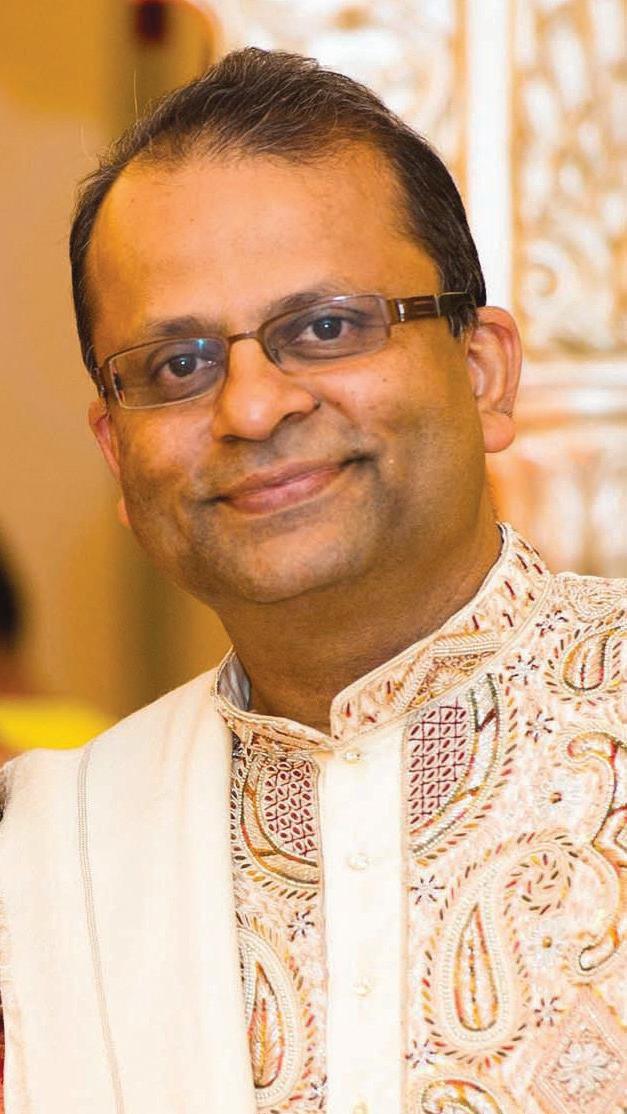
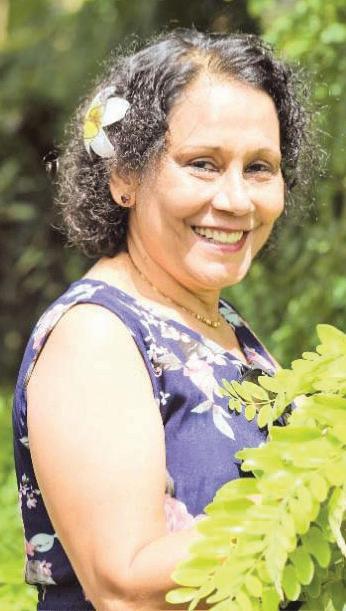
the Annual Find-Raising Luncheon of Ananda Mandir, held on Sunday, July 21, 2024, two members were recognized for their service to the organization.
Sajal Mukherjee was recognized as a Distinguished Leader for his “outstanding leadership in broadening and sharpening scope of Ananda Mandir’s cultural activities and for planning and presenting first-rate programs and building alliances with local artists and organizations.”
Ruby Sarkar was recognized as an Outstanding Volunteer for “taking full responsibility for planning and implementing our food distribution program for our major pujas during the past several years.”
We salute Sajal and Ruby for their dedicated service to the organization.
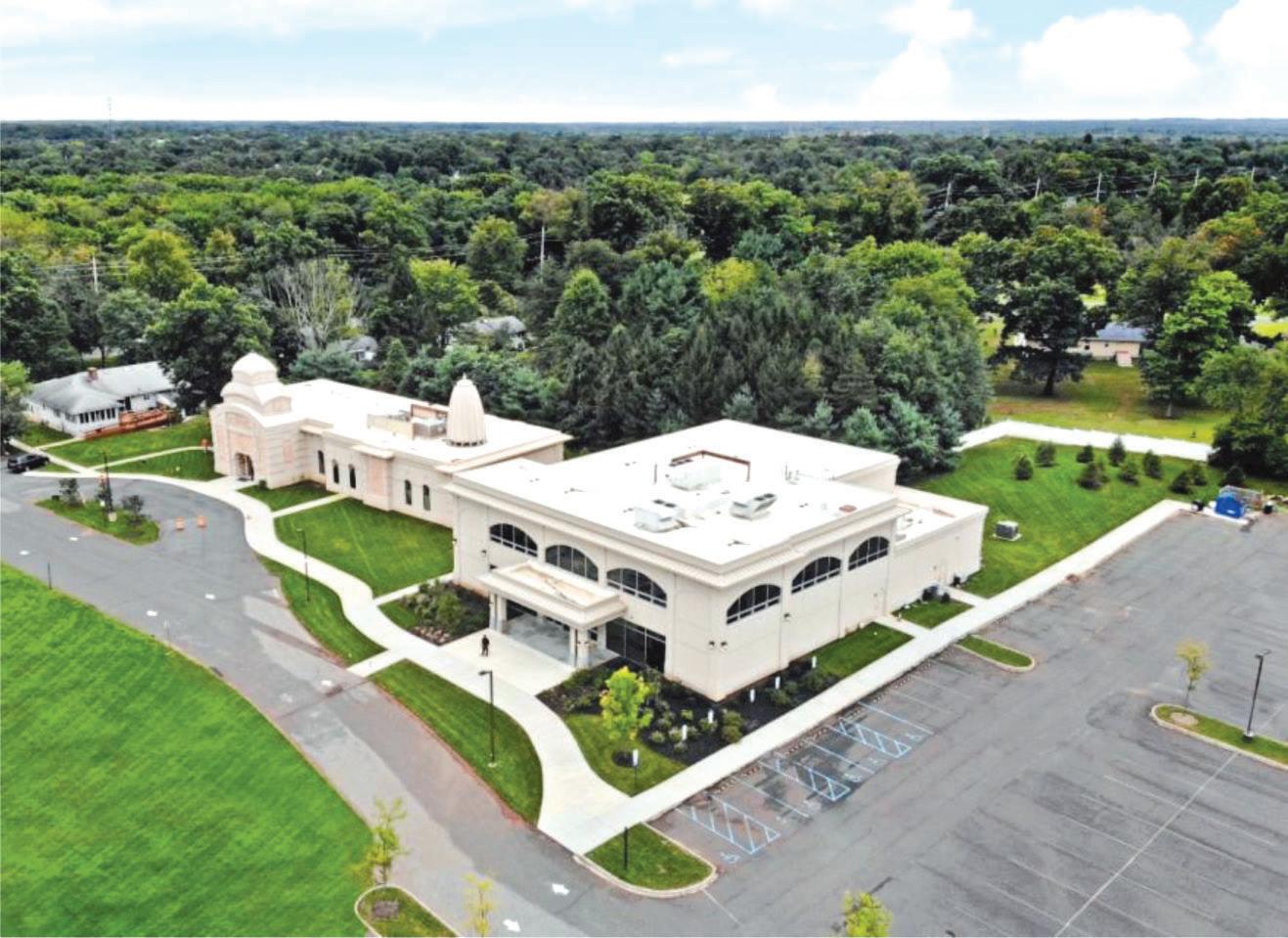
Available to members of the South Asian Community for celebratory events. Please contact Kirit Dalal (732.873.8300) for details about amenities and availability